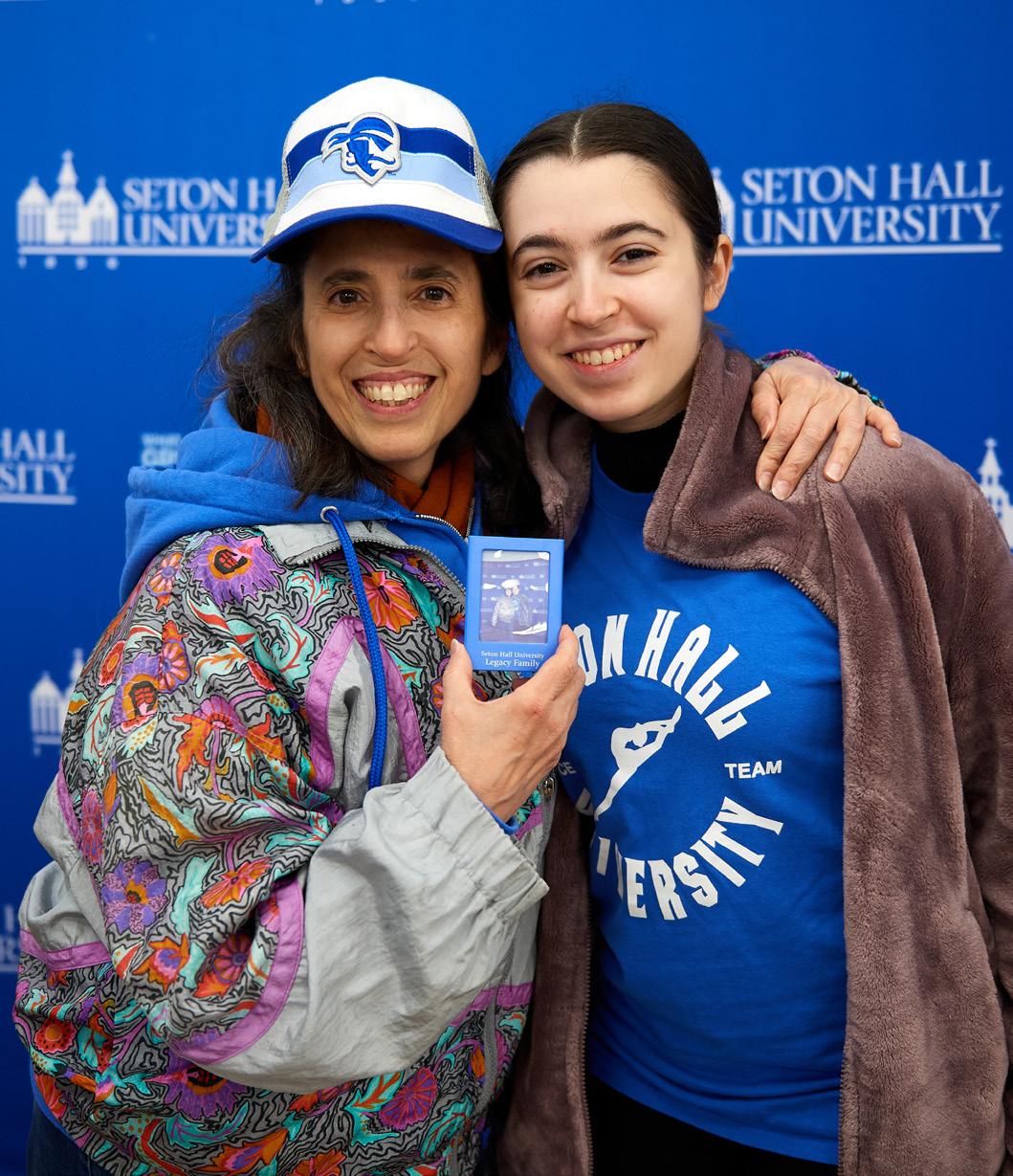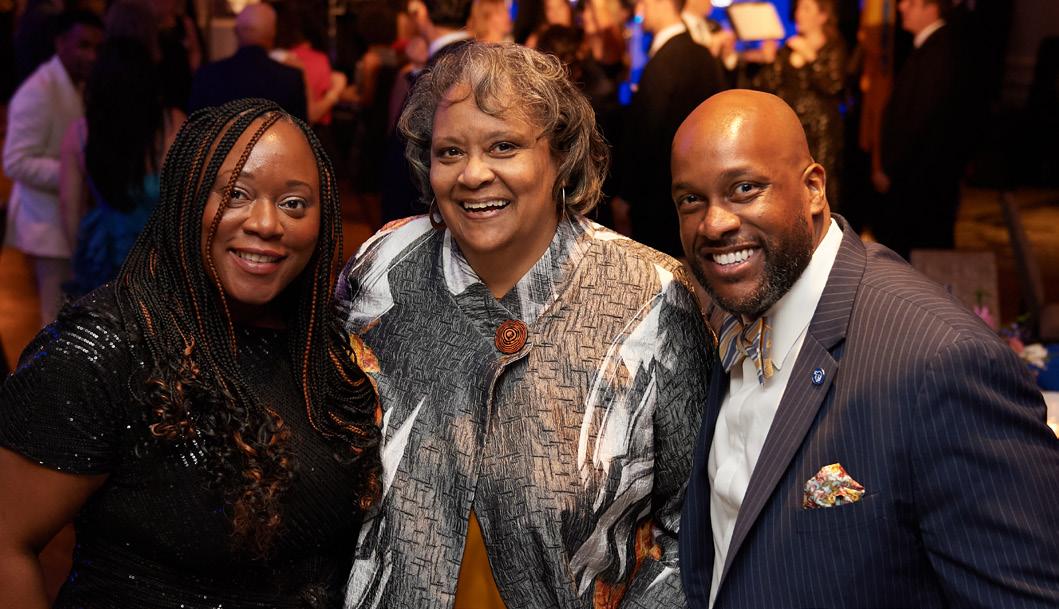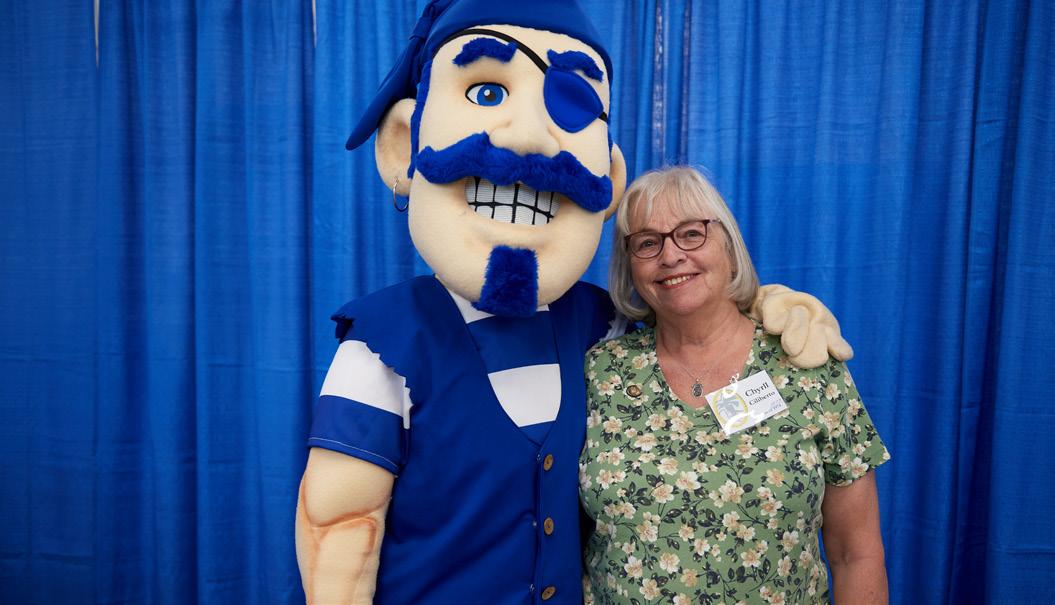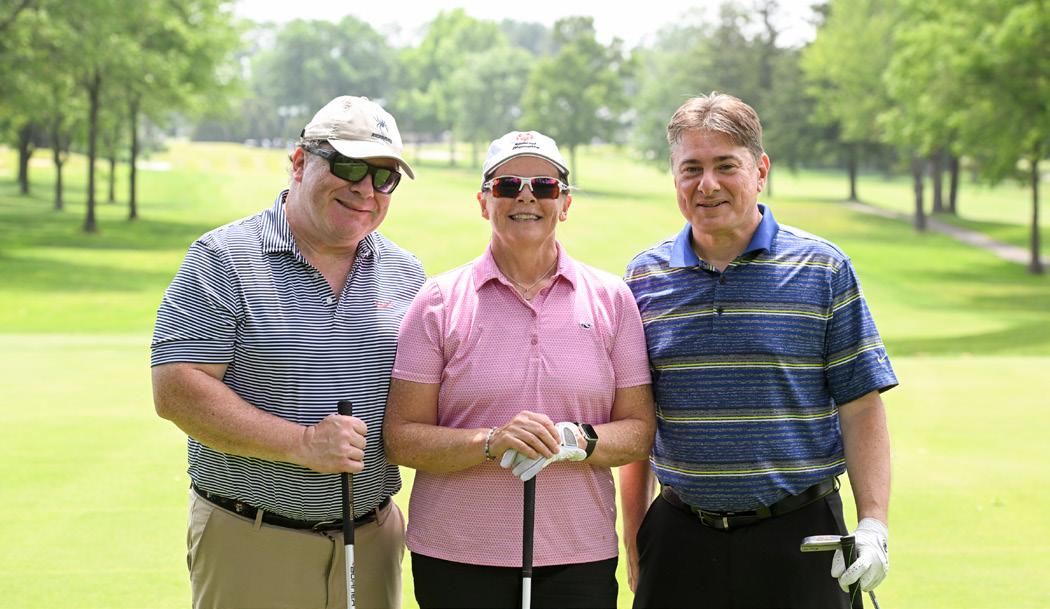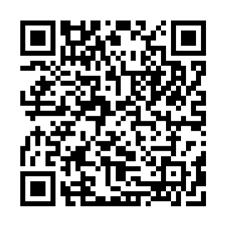SETON HALL
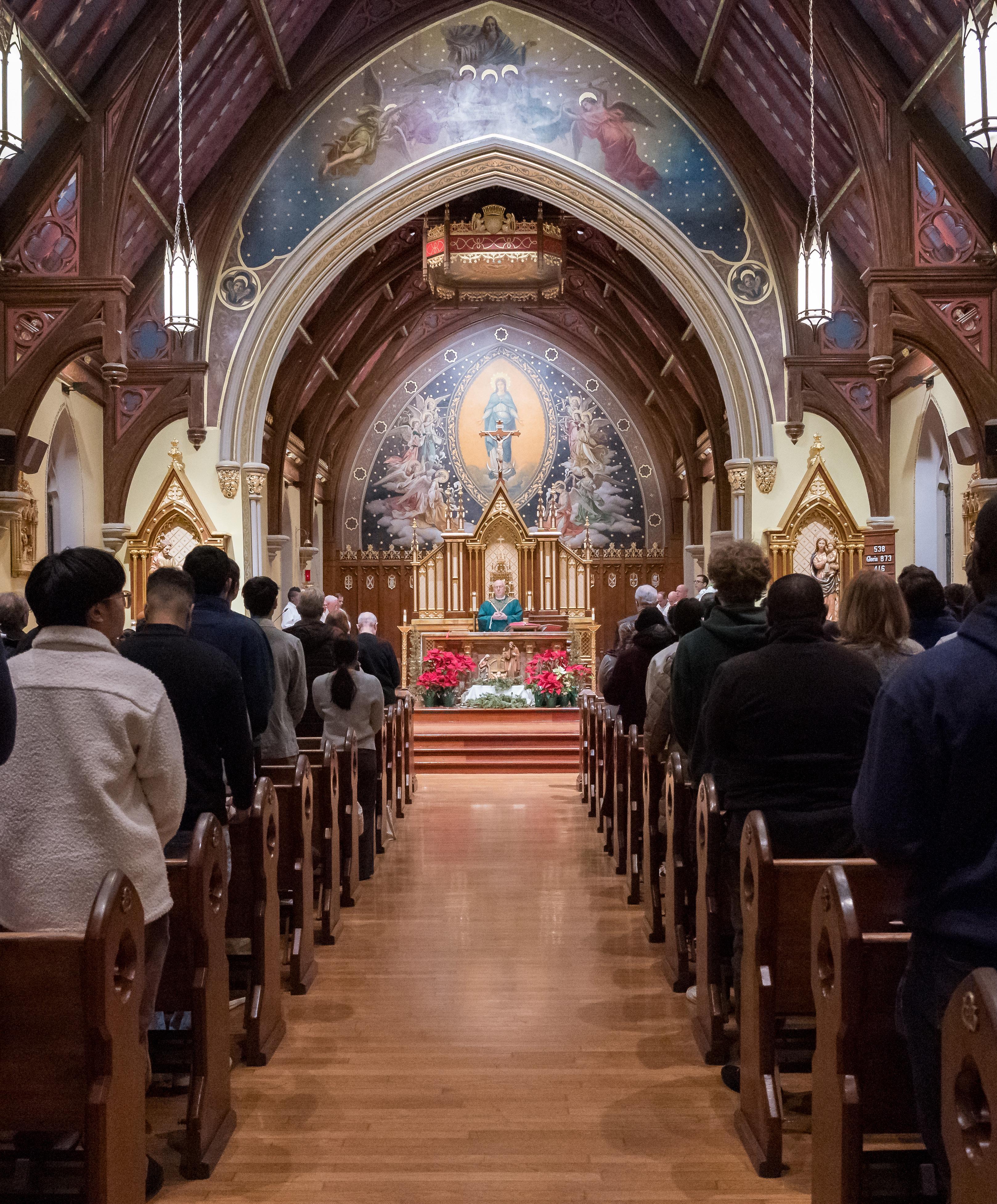


HOW FAITH COMES ALIVE AT SETON HALL
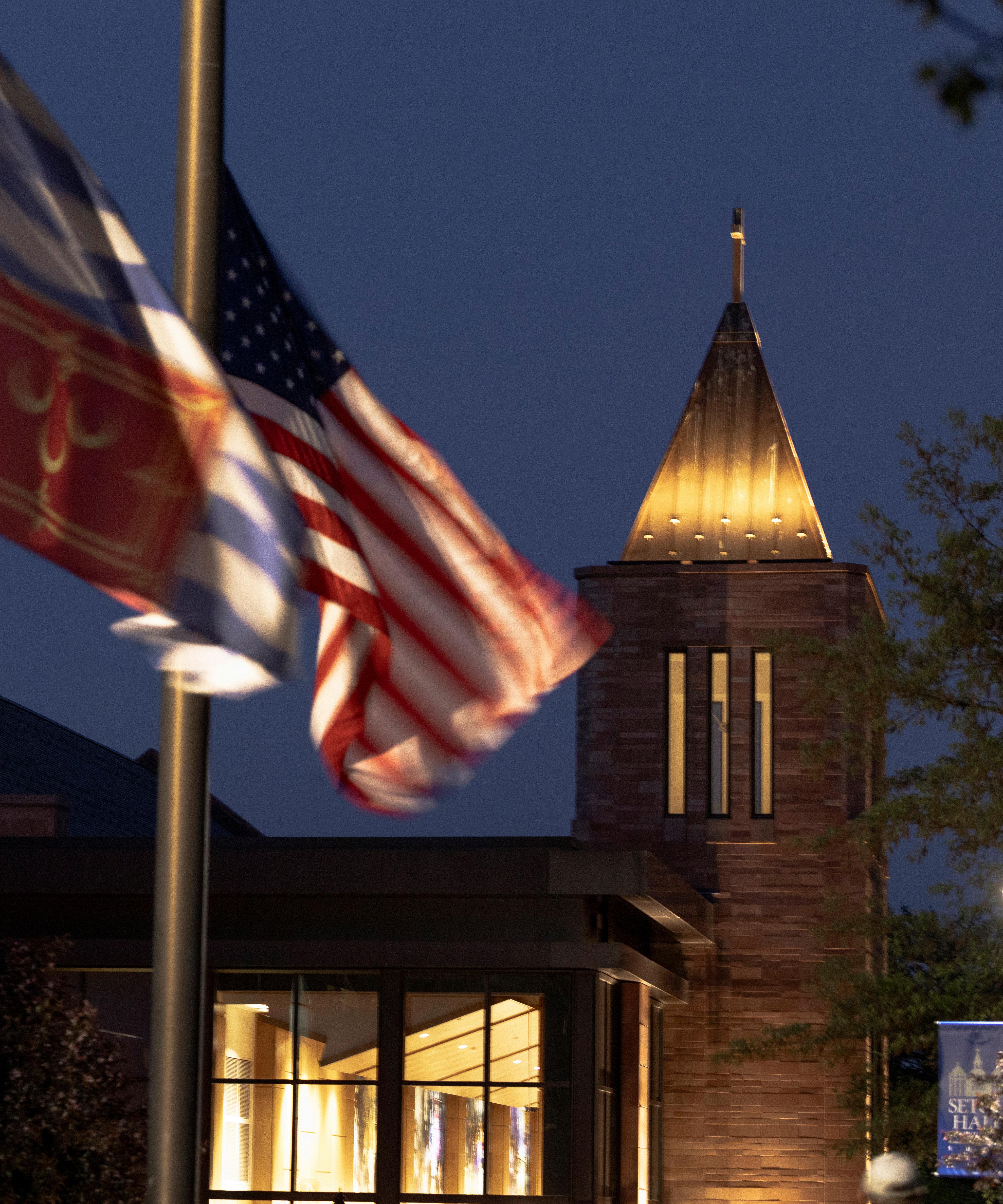
Seton Hall magazine is published by the Division of University Relations.
President
Rev. Msgr. Joseph Reilly, S.T.L., Ph.D.
Vice President for University Relations
Matthew Borowick ’89/M.B.A. ’94
Assistant Vice President, Strategic Communications and Brand
Pegeen Hopkins, M.S.J.
Associate Director, Strategic Communications and Brand
Emily Heric, M.A.
Art Director
Ann Antoshak
Copy Editors
Kim de Bourbon
Zachary Cooney ’20
News & Notes Editors
Trevor A Russomanno
Aaron Smith
Send your comments and suggestions by mail to: Seton Hall magazine, Division of University Relations, 519 South Orange Avenue, South Orange, NJ 07079; by email to shuwriter@shu. edu; or by phone at 973-378-9834.
Seton Hall magazine staff reserve the right to edit submitted content and cannot guarantee that items received will appear in the magazine. Publication of an item does not constitute endorsement by Seton Hall.
Cover: Mass in the Chapel of the Immaculate Conception.
Photo by Joy Yagid.
Facing page: Bethany Hall.
Photo by Bob Handleman. www.shu.edu
A chronicle of how faith comes alive at Seton Hall University.
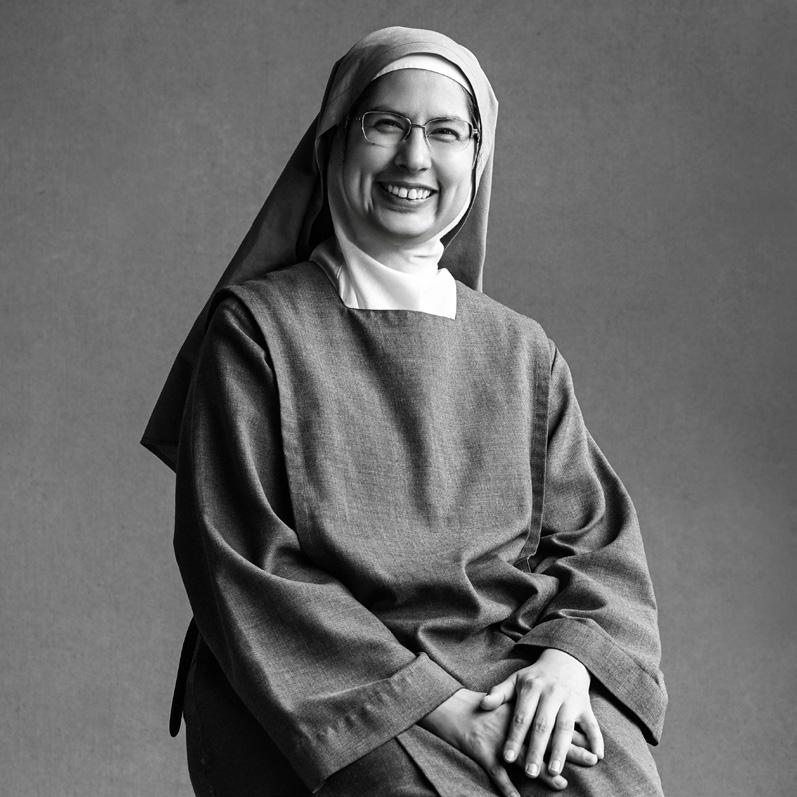
Farnsworth Hendrickson and Miguel Freire covered Super Bowl LIX as part of the University’s new Pirates in the Field program.
Associate Professor Joseph Huddleston spent his sabbatical in Washington, D.C., where he worked on legislation in response to a changing political landscape.
Frank Fontaine, M.A.E. ’14 combines his passions for music and teaching to enhance the experience of his students.
Maureen Wadiak ’80 looks back at the benefits of a private education and the decision to establish an endowed scholarship.
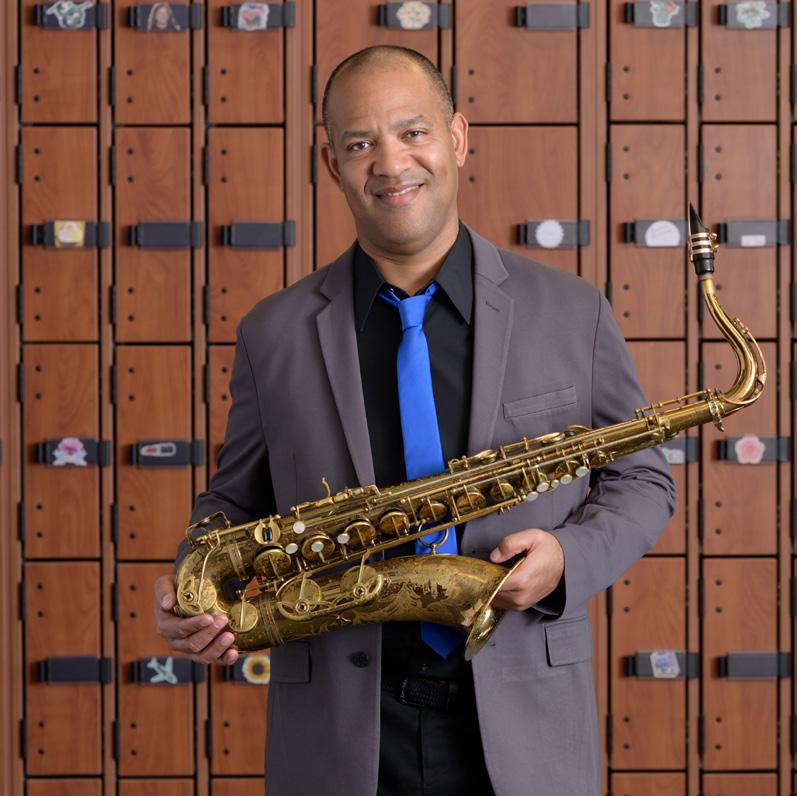
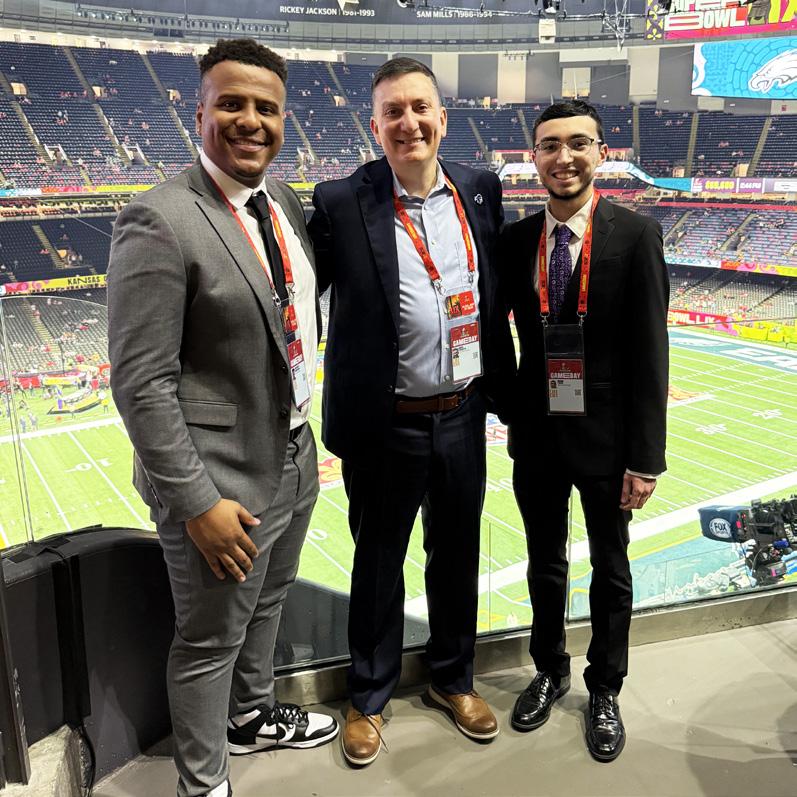
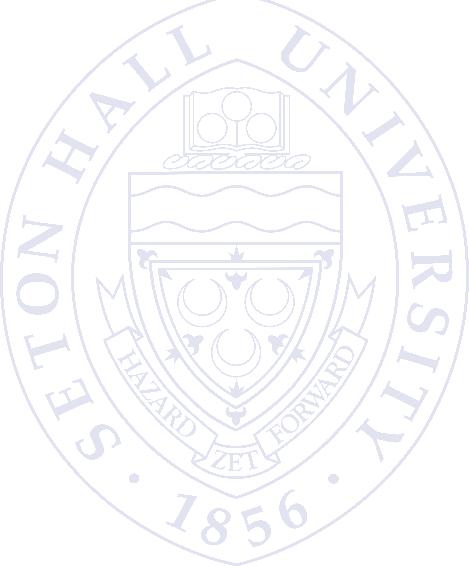
Ihave been reflecting on the blessings of serving as president for nearly a year now. Chief among them has been the support of alumni across the country — from New York to Las Vegas, North Carolina to Chicago and from Florida to Texas to Utah. Visiting each place, I came away feeling even more invigorated, uplifted and confident in Seton Hall’s future.
Hearing stories from graduates about the lasting impact Seton Hall has had on their lives — how they have found their life partners and discovered their life’s calling — has been so heartening and inspiring for me as a priest, alumnus and leader of Seton Hall. It is truly a gift!
This has impelled me to share a vision for the University we all love — a University with a great history, dynamic present and exciting future.
With the help of God’s grace, we are bringing new life to the unique Catholic mission that distinguishes us in American higher education. This means advancing Seton Hall’s identity as a community of welcome, one in which people are respected and encouraged to share their gifts, and a place of hopeful encounter, where everyone can discern God’s plan for their lives.
Grounded by our Catholic faith, we know that every person is made in God’s image and likeness. Because of this, we also know there is great value to developing the entire person — in mind, heart and spirit — so he
or she can contribute to society as God would have it. This means applying our Catholic perspective to every field of study.
Rooted in our past and fixed firmly in this present moment, the possibilities for our future are limitless. To achieve that future, we are developing a robust strategic plan that builds on the success of our previous strategic plan, Harvest Our Treasures. This communal endeavor is the product of nearly two years of deliberation, and through it, we will express our Catholic mission in transformative ways.
The plan, which we expect to finalize by the end of the year, will guide us in reinforcing faith and education throughout the Seton Hall experience. It will focus on academics. It will focus on career preparation. It will focus on student life. And it will focus on our Catholic faith and values.
It will engage our community in different ways, as we are all uniquely gifted, and God calls each of us to distinct paths of growth. By embracing this wealth of experiences, we reaffirm our dedication to nurturing great minds, empowering students to discern their greater purpose.
The strategic plan will arrive amid a special year for our patroness, Saint Elizabeth Ann Seton. Last August, we celebrated the 250th anniversary of her birth. And September 14 will mark the 50th anniversary of her canonization. Mother Seton continues to offer us much
With the help of God’s grace, we are bringing new life to the unique Catholic mission that distinguishes us in American higher education.
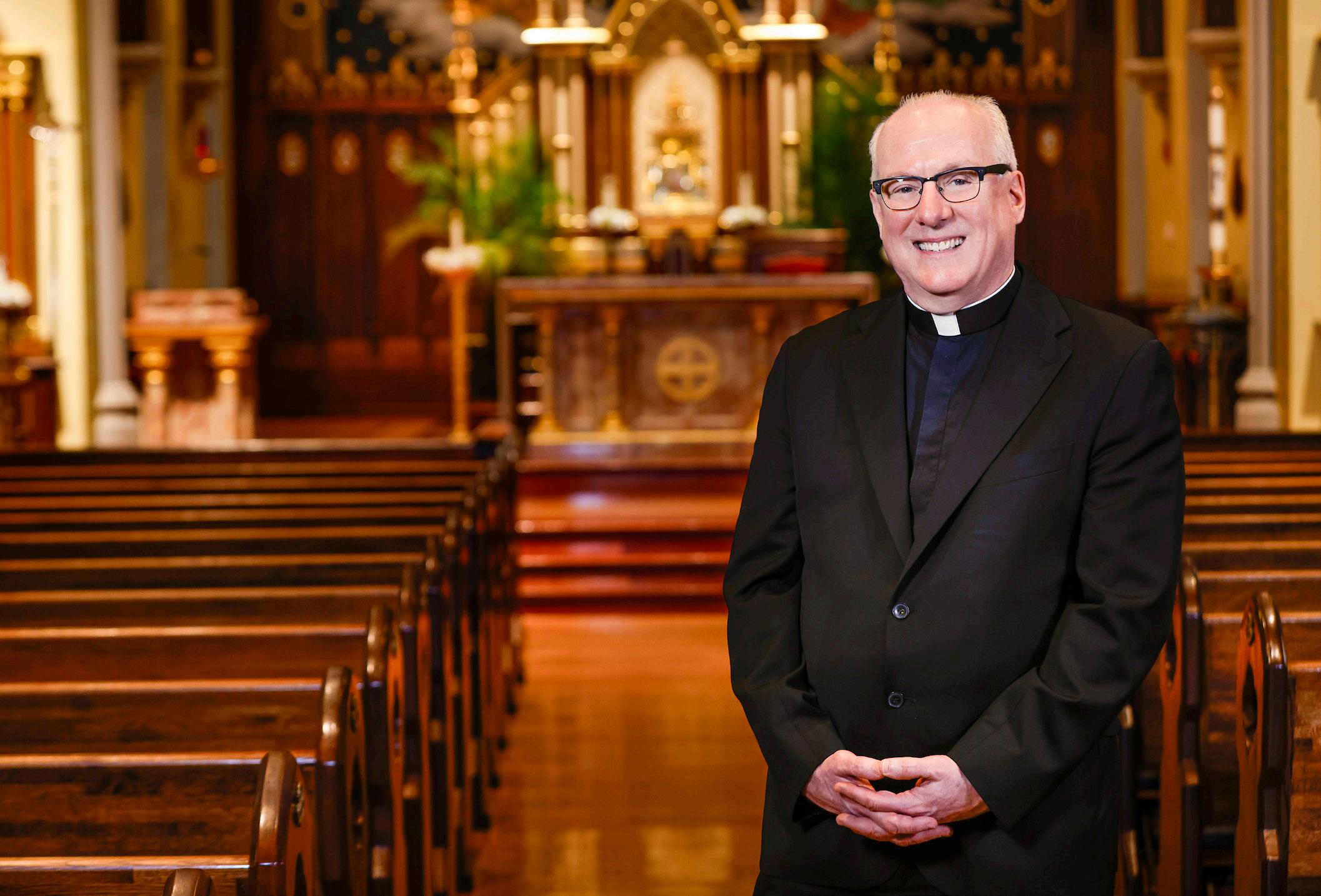
wisdom, which we take to heart. In fact, the strategic plan highlights values that arise from her life and experience as an educator and a woman of faith and vision. They are:
n Faith and Hope
n Trust and Integrity
n Courage and Curiosity
n Compassion and Service
n Love and Action
n Purpose and Resilience
In watching the plan develop, I have witnessed the process grow from the ground up. It is being shaped by the hopes, goals and priorities of students, faculty, staff, priests, administrators and board members — the same individuals who will bring it to life every day on our campuses. I’ve been inspired and thrilled with
the singular focus that is being brought to bear by everyone involved.
When the plan debuts, I am confident our alumni will be supportive of its precepts and goals. Everyone will have an opportunity to help elevate the University, take advantage of unforeseen opportunities and realize our sincere hopes and most heartfelt dreams.
This momentum is generating a terrific amount of goodwill and optimism on our campuses. There is more than hope; there is an expectation of Seton Hall’s bright future.
I am indebted to each of you, and grateful for the privilege of leading this singular institution. I look forward to sharing my love for the University as we continue our progress. And I am counting on your prayers and support as we realize our exciting strategic vision for Seton Hall. n
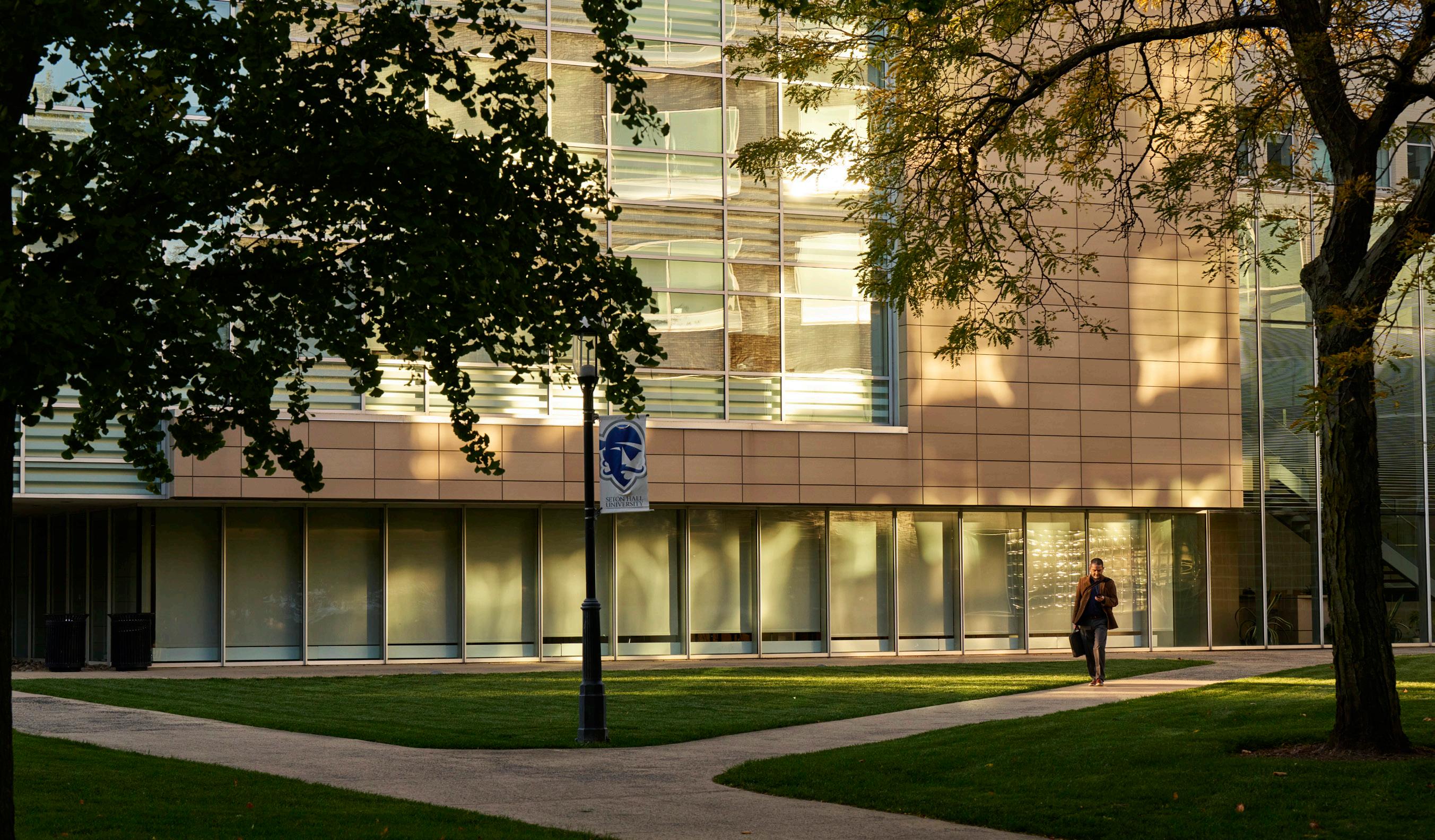
l Courtney B. Smith, dean of the School of Diplomacy and International Relations and vice dean of Seton Hall School of Law, has been named a member of the Council on Foreign Relations.
l Last November, Gregory Y. Glazov, professor and chair of Biblical Studies at Immaculate Conception Seminary School of Theology, became a research scholar of the Northwestern University Research Initiative in Russian philosophy, literature and religious thought.
l Edmund Adjapong, associate professor and secondary education program director for the Department of Educational Studies, published a book called Teach Like an MC: Hip-Hop Pedagogy in the K-12 Classroom, highlighting practical ways to infuse the hip-hop culture in education.
l U.S. News and World Report ranked Seton Hall’s online graduate education programs in the top 25 percent in the U.S. The programs also earned the distinction of being third among all Catholic colleges and hold the same ranking overall in New Jersey.
l Ines Angeli Murzaku, professor of religion, received a Fulbright U.S. Scholar Award to Cluj-Nopoca, Romania, for the spring semester.
l The Stillman School of Business reaffirmed its status with dual accreditation in business and accounting from the Association to Advance Collegiate Schools of Business, remaining among the less than 2 percent of business schools worldwide to hold both.
l Seton Hall University unveiled an interactive website for its Great Minds Dare to Care initiative and The Well Mental Health Toolkit, providing students and faculty with accessible and practical mental health resources.
l Kristi Stinson, interim dean of the College of Nursing, was accepted into the National Academies of Practice as a professional member.
l Jurga Marshall, associate professor, Department of Physician Assistant, received a 2024-25 Don Pedersen Research Grant from the Physician Assistant Education Association.
l La’Tesha Sampson, director of the Master of Public Administration program, was recognized with one of the highest civilian honors bestowed by the White House: the President’s Lifetime Achievement Award. This accolade, established by President George W. Bush, recognizes individuals who have dedicated more than 4,000 hours of service to the community.
Seton Hall’s brand strategy — which underpins the identity the University shares with the outside world about its purpose and personality — has been refreshed.
“The Seton Hall brand lives in our decisions, the culture we create and the relationships we forge,” says Pegeen Hopkins, assistant vice president for strategic communications and brand. “It’s also a reflection of our personality and how people experience the University. Our research shows that Seton Hall’s personality is inspiring, dynamic and spirited.”
Looking to better understand how the University’s brand was experienced post-COVID, Seton Hall partnered with Ologie, a marketing agency specializing
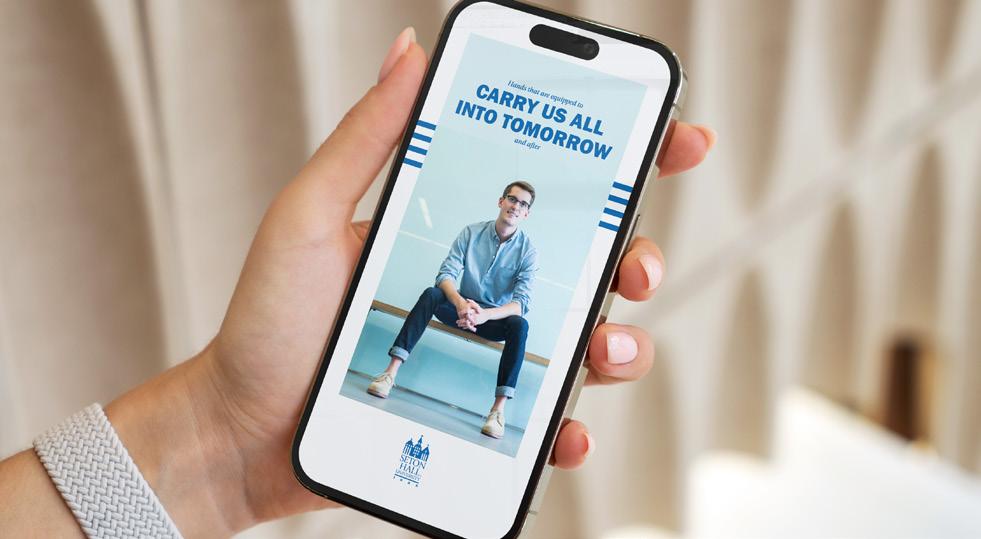
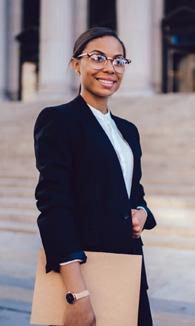

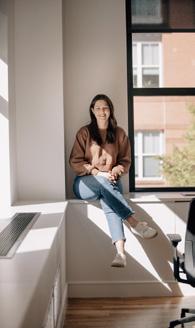

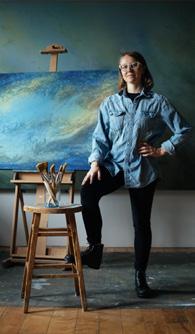
in colleges and universities, to conduct research and to interview University community members. Based on the updated information, the team developed a unified platform — including a creative toolkit and comprehensive strategy — to give everyone a direct and consistent understanding of what Seton Hall is all about, and how to go about sharing that message.
A workshop in January explained how the strategy can be worked into writing, videos, photography and more, and a new website will provide practical resources.
“A brand is more than a tagline, a logo or even a color palette,” Hopkins says. “By keeping the strategy platform in mind when we communicate about the University, we can represent Seton Hall most effectively.”
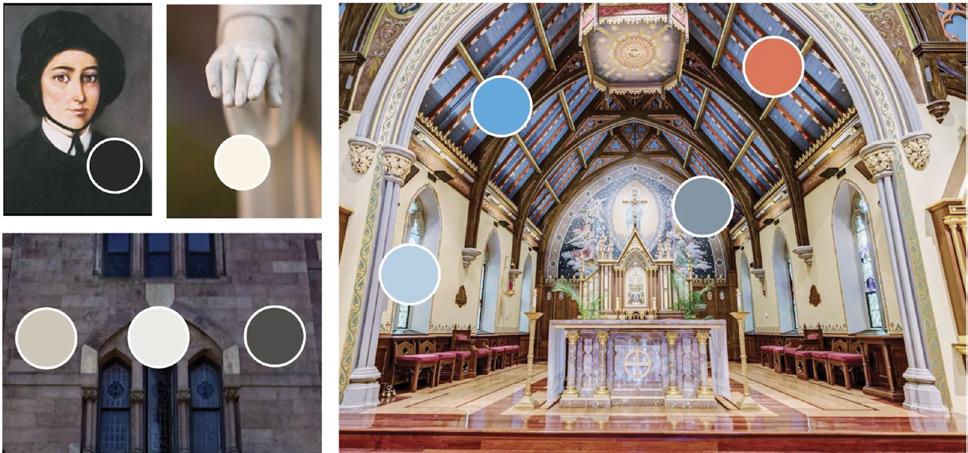

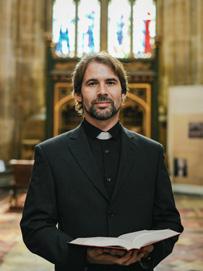
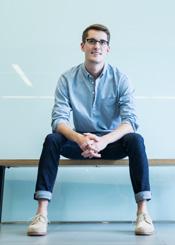
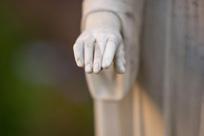
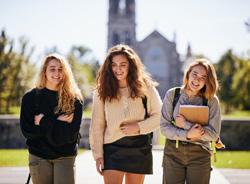


Leftovers from the Seton Hall cafeteria are being left over no longer. Gourmet Dining Services is preparing meals-to-go from food not eaten, and students are distributing them to the hungry in a partnership with New Jersey’s most extensive food distribution network.
The food rescue effort, a collaboration with Table to Table, has been driven by Shayne Simmons, a master’s student in the public administration program who as an undergraduate was involved with the Food Recovery Network Club on campus.
“I believe all operations at Seton Hall should embody the mission of servant leadership,” says Simmons, who was honored by the University’s Division of Volunteer Efforts.


The meals are prepared every other week, loaded into a car and delivered by students to organizations such as the Jesus Saves boarding house in nearby Newark. The initiative is also being supported by the University’s Environmental Sustainability Committee.
Almost all those graduating from Seton Hall’s Bachelor of Science in Nursing program passed their 2024 national licensing exam on the first try, breaking the University record and significantly exceeding the national average.
The College of Nursing program achieved a 97.4 percent first-time pass rate on the National Council Licensure Examination, which determines readiness for entry-level nursing positions. Beyond a standard knowledge-based test, the exam asks candidates to use critical thinking to make clinical judgments. The national average last year was 92 percent.
The pass rate “underscores the college’s commitment to preparing skilled nursing professionals, strongly positioning Seton Hall as a noteworthy institution in the field of nursing education,” said Kristi Stinson, interim dean of nursing.
Additional tools for helping the campus community maintain its mental health have been launched with an interactive website for Seton Hall’s “Great Minds Dare to Care” initiative, which includes an online toolkit called “The Well” that offers guidance on a wide range of challenges.
The revamped platform, funded by the New Jersey Division of Mental Health and Addiction Services, includes help for both students and faculty.
Students can find a student-created video on “How to Help a Friend,” a guide to recognizing when help is needed, and self-help tools designed to promote emotional wellness and resilience.
Faculty can find videos on how to respond to students in distress, guidance on when and how to take action, and strategies for building good mental health practices into their courses.

The new website and online tools are a collaboration between the Dean of Students Office, Counseling and Psychological Services, the Division of University Relations, and the Teaching, Learning and Technology Center.
Award-winning novelist Alice McDermott discussed her books and read from her work on April 1 as the featured guest in the University’s Poetry in the Round series, which has brought top contemporary writers to campus for more than 30 years.
McDermott read from her latest novel, “Absolution,” a New York Times bestseller and winner of the 2024 Mark Twain American Voice in Literature Award.
The author treated the audience to “an amazingly compassionate, smart, and funny reading and discussion of her work and the gift of reading,” reported Jonathan Farina, English professor and interim dean of the College of Arts and Sciences.
She also discussed her career and took questions from the audience at the event, hosted by the Seton Hall Arts Council.
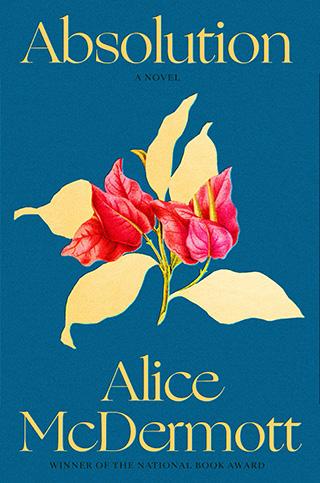
Two teams from the Seton Hall University School of Law came back to campus with wins in two national moot court competitions this winter.
The competitions offer an appellate-style argument in which law students argue hot-button issues currently pending before state and federal courts.
In January, third-year law students Emma Taylor and Christopher Frey won the Hicks Thomas LLP Moot Court National Championship in Houston, marking a first-time win for Seton Hall Law.
The Hicks Thomas competition invites the top 16 law school moot court programs to compete in three days of legal argument and collaboration.
Seton Hall saw rounds against Southern Methodist, Baylor, George Washington University, Michigan State, Loyola Chicago and New York University before defeating Liberty University in the final round. The team also won Best Brief honors.
In March, third-year law school students Shea Moran and Emme Anderson won the Robert F. Wagner National Labor and Employment Law Moot Court Competition at New York Law School.
The competition featured 40 teams engaging in a real-world legal problem focused on the Americans with Disabilities Act and non-compete agreements.
The team also won an award for writing the best respondent brief, and Anderson received the Best Final Round Oralist award.
At the end of March, Seton Hall Law hosted its own contest, the John J. Gibbons Criminal Procedure Moot Court Competition, featuring more than 40 law schools from across the country focusing on criminal procedure and criminal law.
Seton Hall Law School’s Interscholastic Moot Court Board is ranked No. 6 in the nation.
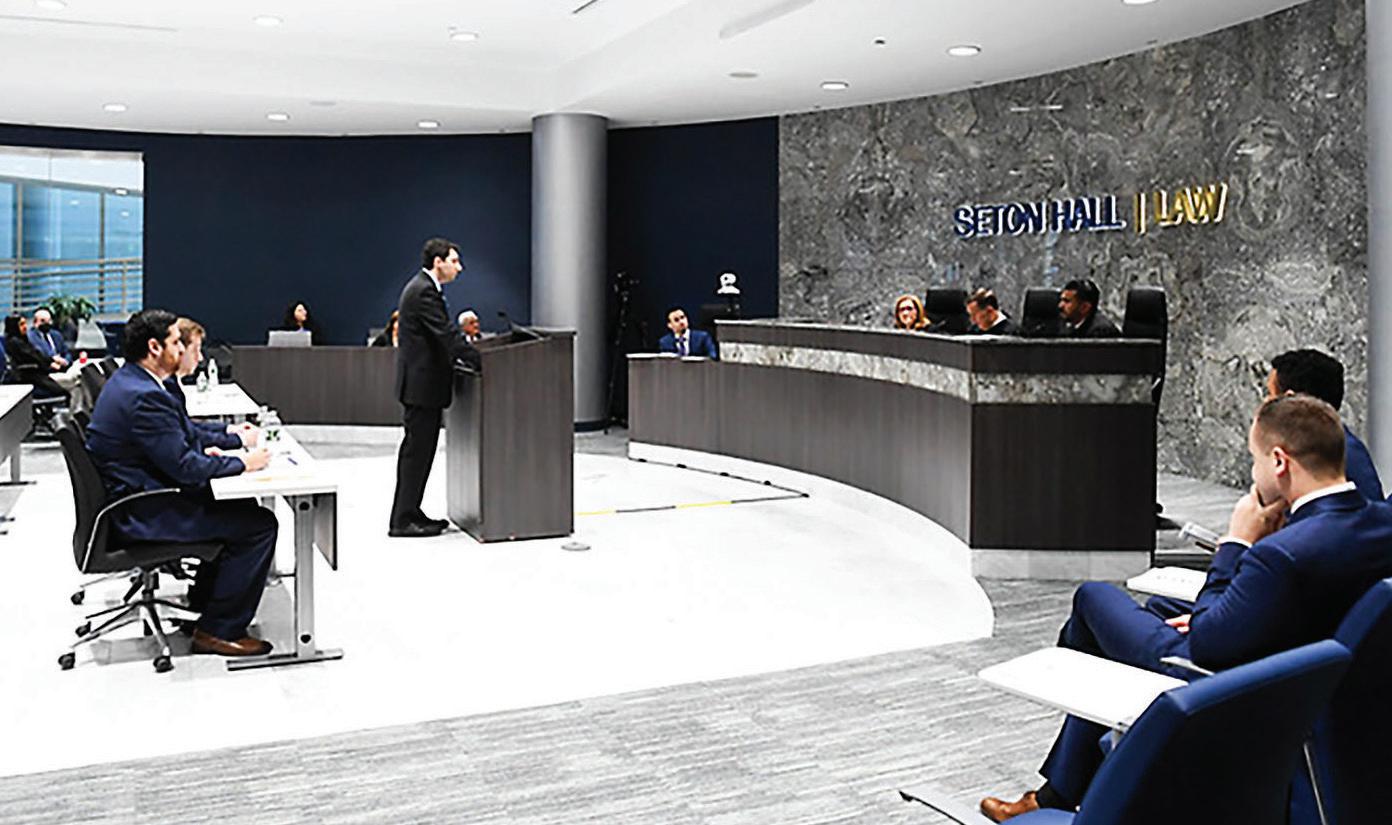
The transportation services that students, staff and guests use to get around both on- and off-campus have new names, new looks, and a new way to access routes and scheduling through a mobile app.
The Seton Hall Shuttle (formerly known as SHUFly) runs until 3 a.m. every day of the week during the fall and spring semesters, following a fixed route and designated stops on campus and in the village of South Orange. The schedule starts at 6 a.m. Monday through Friday, at noon Saturday and 11:30 a.m. on Sunday.
SHU Ride, offered by the Department of Public Safety and formerly known as Safe Ride, is designed as a safe way to travel at night from the campus to locations in the immediate area not on the Seton Hall Shuttle route. This on-demand service to and from the Public Safety building is available every day from 5 p.m. to 3 a.m.
A Seton Hall ID is needed for both services, but the ride is always free.
Both services use a transportation app called TripShot. It offers real-time tracking of the shuttle, so its location can always be seen.
As part of the overhaul, the look of the vehicles was updated after a student vote on prospective designs.
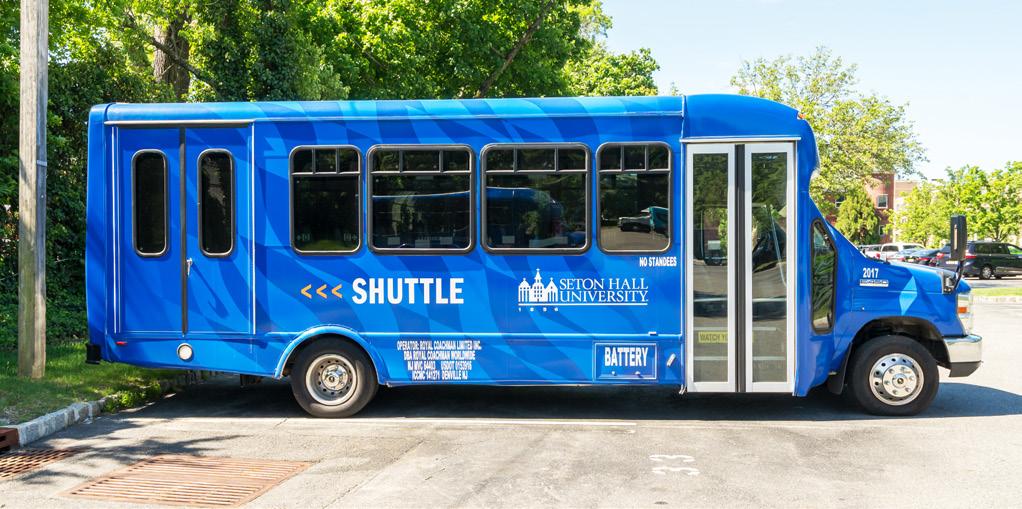
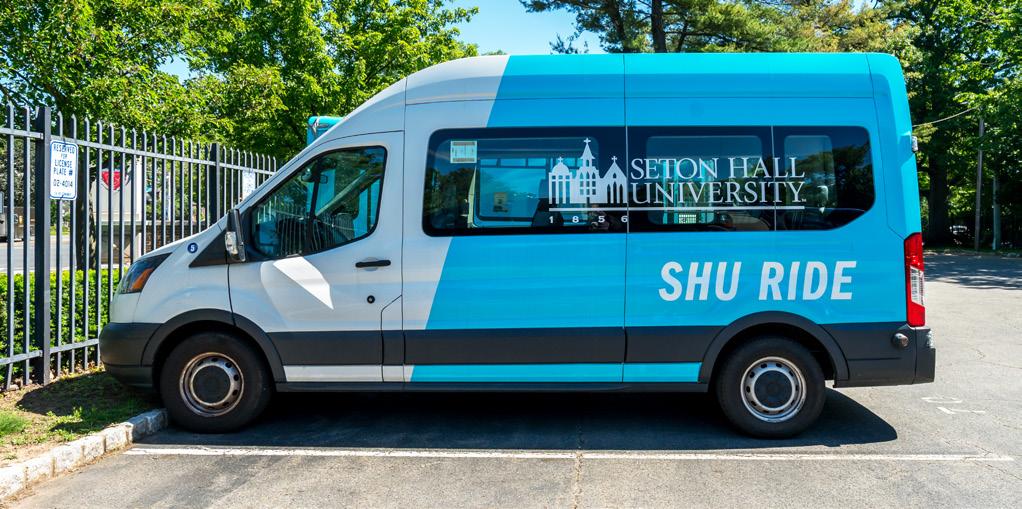
“I think there was a sense of nostalgia for the place that they had grown up in, which might seem strange given the oppression that they had faced.”
Thomas Healy, School of Law, PBS Great Migrations: A People on the Move, from Henry Louis Gates Jr., discussing the mindset of African Americans who decided to migrate back to the South.
“We need to help students — whether it be through job shadows or internships or just the art of networking and interviewing — [learn] how to succeed.”
Jorge E. Rivera, Career Center director, ROI-NJ, on the importance of being there for all students in their search for career success.
“In other words, Regulation E does not cover you when you initiate or authorize a payment, even if you have been tricked into the payment.”
Jennifer Itzkowitz, Stillman School of Business, NJ.com, explaining the Regulation E provision of the Electronic Funds Transfer Act in cases of a scammer tricking someone into a victim-assisted fraud.
“Global health scholars are concerned that the U.S. is isolating itself from global health governance; when the next pandemic hits the planet, the lack of timely information on the pathogens is going to hurt the United States.”
Yanzhong Huang, director, Center for Global Health Studies, CGTN America, discusses the potential impact of the United States withdrawing from the World Health Organization.
“From a political perspective, gold bars, a Mercedes-Benz and cash in a duffel bag at the bottom of your closet are sensational, unbelievably eye-catching visuals.”
Matthew Hale, College of Arts and Sciences, Law360, on the sentencing of former U.S. senator Robert Menendez.
“This year, both the Gregorian calendar used in the West and the ancient Julian calendar used in the East will have Easter fall on April 20, so all Christians in the world will be celebrating Easter on the same day.”
Peter Ahr, professor emeritus of religion, Jersey Catholic, discussing the Church’s openness to a common celebration of Easter on a date agreed on by all.

Students Farnsworth Hendrickson Jr. and Miguel Freire explore the world of sports journalism while covering Super Bowl LIX.
When the mom of a Seton Hall senior came to his dorm room with a suitcase, it wasn’t to help him pack for move-out day.
Farnsworth Hendrickson Jr. was about to embark on the experience of a lifetime: a weeklong trip to New Orleans, where he and fellow student Miguel Freire would be on assignment to cover Super Bowl LIX as members of the news media.
The opportunity was part of the University’s new Pirates in the Field program, a Center for Sports Media initiative that gives students hands-on experience producing sports-related content and pitching stories to local and national news outlets. Covering the Super Bowl was one of six high-profile opportunities students could apply for during the 2024-25 school year.
“My mom cried!” says Hendrickson, recalling when he told her he was selected for the Super Bowl assignment. He was excited to build on his media production experience, which already included roles with Awesome Films and the University’s student-run Pirate TV.
Both Freire and Hendrickson graduated in May with bachelor’s degrees in visual and sound media. Freire, an avid sports fan who was active with Seton Hall media like Pirate Sports Network and WSOU 89.5 FM, was shocked when he got the news. “I honestly didn’t think I’d be one of the two students picked to go to the Super Bowl,” he says. “When I read the email, I was like, ‘Oh wow, it was me.’”
They had less than a month to prepare, which also involved working with the Center’s executive director B.J. Schecter, who launched Pirates in the Field in 2024.
“Miguel and Farnsworth earned the right to go to the Super Bowl and stood out from the pack in a very competitive application process. They’re hard working, fearless and very coachable,” says Schecter, who has more than 30 years of experience in sports media, including two decades at Sports Illustrated
The students were in New Orleans for seven days, using their credentials to cover many Super Bowl activities leading up to and including game day, alongside more than 6,400 media professionals from
around the world. “These two jumped right in and produced great content from Day One at opening night, which is a circus,” says Schecter. “They were unafraid to go up to players and secure interviews. That was very impressive.”
The duo conducted one-on-one interviews with Philadelphia Eagles linebacker Josh Sweat; asked questions during press events with Kansas City Chiefs head coach Andy Reid and retired coach and sports analyst Jimmy Johnson; and chatted with player-turnedmedia-personality Michael Strahan at the FOX Sports compound. Together they produced six original videos for the Center’s social media platforms, hosted a wrap-up podcast, and shared lots of behind-the-scenes content from their time in New Orleans.
Expecting the unexpected was one way the pair approached their assignment. Robust pre-production planning was another, spending many nights in strategy sessions before their trip.
“We’re throwing every little idea on the table, no matter how simple or difficult it may be,” Freire says. “Even if we’re not going to be able to accomplish it, because maybe we’d need $1,000 worth of equipment or something like that, it was about pitching the ideas. That’s what Pirates in the Field is all about — improving our abilities to develop, pitch and execute on our own ideas.”
During their experience working on Media Row, where media outlets from across the globe host live broadcasts and conduct interviews, they observed a lot of collaboration in the industry. “We saw teams of people with many pieces of equipment, all playing a role,” Hendrickson says.
“When it came to editing our videos, Freire was the voice in my ear saying, ‘Hey, maybe do this, or try that,’” Hendrickson says, reflecting on his and Freire’s partnership. “That’s what I saw on Media Row, as well. The editing computer may be mine, but Miguel and I edited this together. That is collaboration. And I love that a lot.” n
Lori (Varga) Riley, M.A. ’06, is a freelance writer living in New Jersey.
Associate professor Joseph Huddleston utilizes a sabbatical in D.C. to prepare diplomacy students for a rapidly changing political landscape.
Joseph Huddleston, Ph.D., is spending his sabbatical working in Washington, D.C., on federal legislation that may or may not be enacted. But his time won’t be wasted — he’s learning lessons he’ll be bringing back to his students at Seton Hall.
Huddleston, associate professor in the School of Diplomacy and International Relations, is working for U.S. Sen. Cory Booker, D-N.J., as part of a Council on Foreign Relations fellowship. His duties include writing policy memos and official statements centered on Africa. By the time his stint with Booker ends, Huddleston will be able to share with his students more than how to write a first-rate memo.
“I haven’t been able to metabolize all of these lessons and real-world experiences,” he admitted.
Some have stuck. He can explain how you can work on something for days and then the world changes, priorities shift, and that project becomes an afterthought — or you can work on something that winds up being historically important. Huddleston worked with Booker’s foreign policy team to prepare over a hundred pages of materials for the senator’s record-breaking 25-hour speech on the floor of the Senate.
When Courtney Smith, Ph.D., the dean of the school, met with Huddleston in Washington last fall, one of the first things Huddleston told him was that he had ideas for how to improve DiploLab, the collaborative research space he founded at the school in 2019.
At DiploLab, undergraduate research assistants work closely with professors on research projects and hone the
skills they need for academic, policy making and private sector careers.
Projects at DiploLab have included collecting data on separatist movements — one of Huddleston’s areas of expertise — as well as analyzing the conflict in Yemen, examining the military effectiveness of alliances and coalitions in multinational conflicts and writing analytical pieces on cybersecurity. Commentaries by DiploLab faculty and students have appeared in such high-profile publications as The Washington Post and Foreign Policy
“He’s just a really good and caring teacher,” Smith said, noting that Huddleston talks with his students instead of talking at them, and that he helps students “do the learning, rather than telling them what they should know. International affairs is a complex and rapidly evolving field,” Smith added, “so even if we teach students a whole bunch of facts, those facts are going to change.”
Huddleston also can tell students how the D.C. job market works — he has already had students inquiring about opportunities — from networking to hiring to promotions. He can attest to the value of being collegial and getting along with people. He can explain the influence legislators have on policy, and that if enough constituents call or email a senator or representative about an issue, that could affect their actions.
For years, Huddleston has preached the power of humility, which he calls a “kind of superpower.”
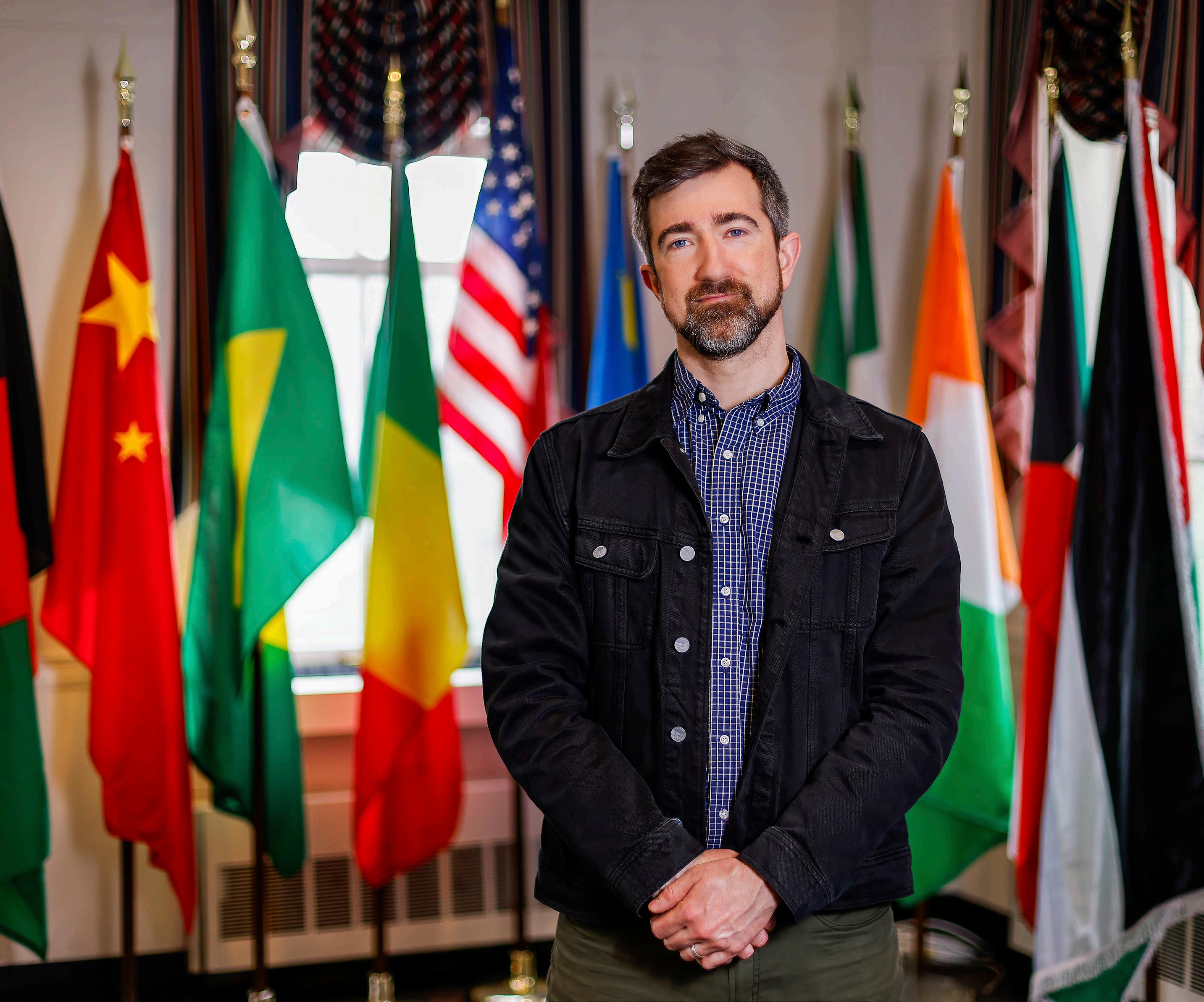
Now, he can tell students that asking for help — “Can you please explain this to me?” — works in the nation’s capital. The person answering the question can build their influence; the person who asks the question gets an ally.
Huddleston’s absence from the classroom doesn’t mean there aren’t lessons to be learned now. A chance exists to show students principles of diplomacy in real time, not as abstractions, and to evaluate what the United States’ relationship with the United Nations will look like in the next 20 or 30 years. Advocacy and
activism, Huddleston observed, are forms of diplomacy that can be practiced by anyone at any time.
When he returns to Seton Hall, Huddleston will have practice to accompany the theory. He can reinforce what Smith cites as one of Huddleston’s key skills: telling students “What they need to ask and what they need to learn. That way they can really help build solutions to these problems.” n
Pete Croatto is a freelance writer based in central New York.
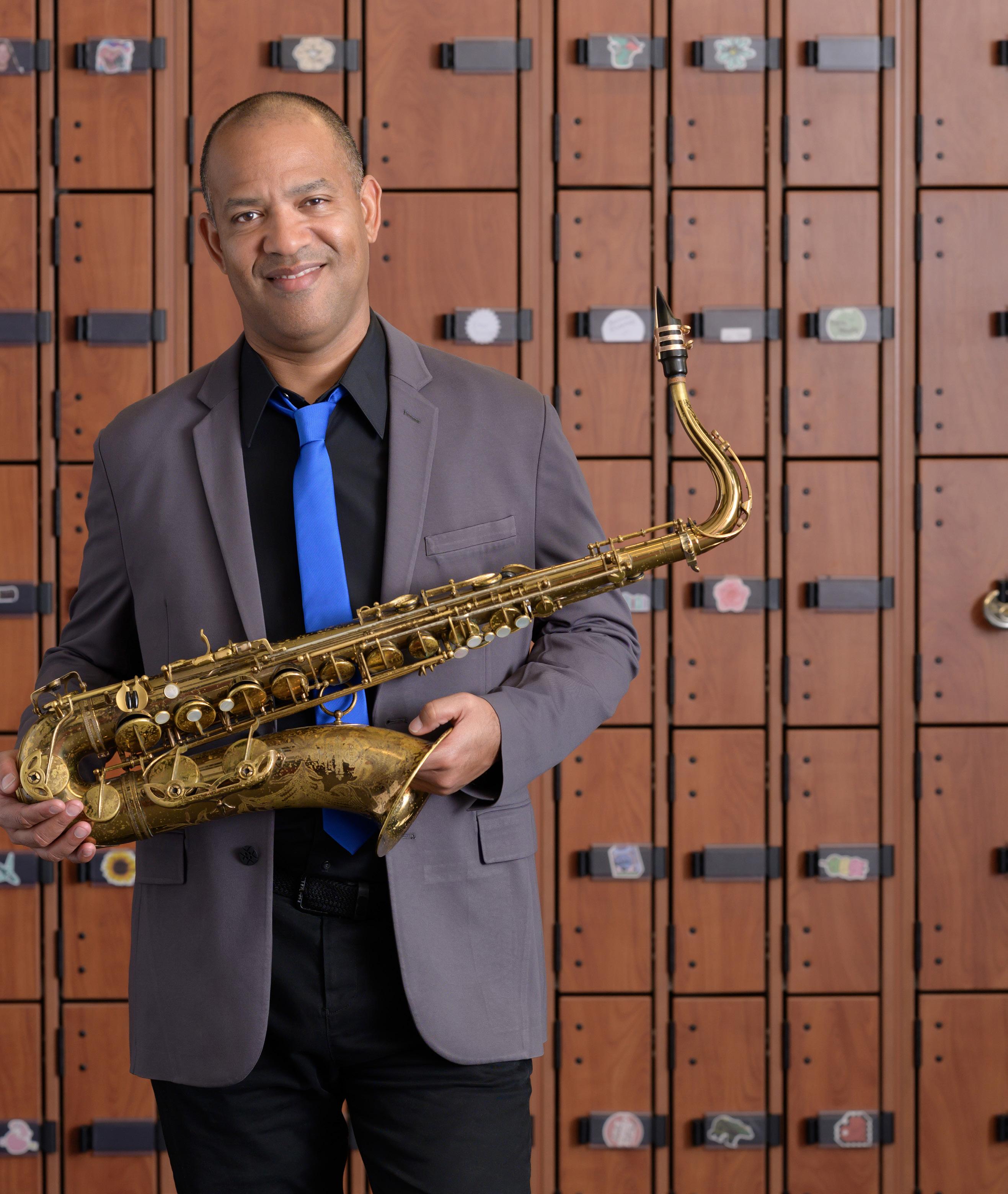
Frank Fontaine connects a passion for music with a passion for teaching, and his students are the better for it.
When you’re under your parents’ roof, the last thing you want to do is be just like them — at least that’s how it worked for Frank Fontaine, M.A.E. ’14. His father, Frank Sr., spent 10 years playing with the legendary Duke Ellington Orchestra, and Frank Jr. had no desire to pick up an instrument.
But in elementary school, a teacher handed him a plastic recorder, and that moment just might have launched a music career that has included four Grammy nominations and led him to become a music educator.
“I wasn’t necessarily very good at that age, but music gave me a way to fit in,” Fontaine says. “I found my people through music.”
But it wasn’t until freshman year of high school that he really zoned in on music. “I attended a concert, watched the saxophone player and got the bug,” he says. “I dropped out of high school, jumped in a Winnebago with friends, and made a go of it.”
Fontaine’s approach to a musical career panned out. After finding a place in the music scene, he returned to his hometown of Los Angeles to finish high school. But to really buckle down, he needed to leave the West Coast. “I knew I wouldn’t be able to focus on school, that I’d be playing gigs,” he admits. “Moving to New York bought me a year or two of anonymity, so I was able to get through undergrad before returning to full-time playing.”
Fontaine pursued his undergraduate degree at the Manhattan School of Music, studying jazz performance and composition. Through connections he made there, Fontaine composed for well-known Latin jazz artist Wilson “Chembo” Corniel Jr., leading to a Grammy nomination in 2009. From there, Fontaine moved to New Jersey to obtain a teaching certification, thinking it would be a one- or two-year stint. “But I fell in love with it,” he says.
Recognizing that in teaching he had found a new and complementary passion, Fontaine began the Master of Arts in Education program at Seton Hall. There, he crossed paths with Joseph Martinelli, senior faculty associate in the Education Studies department, who became his teaching mentor.
“I was far out of my comfort zone, but he helped me find my footing and plot a forward trajectory,” Fontaine explains.
Today, Fontaine is a music teacher and the band and orchestra leader at L.A.’s McAuliffe Middle School. He’s also continuing his education, remotely pursuing a doctorate in music education at Boston University.
Martinelli says that while he gets to know all his students, Fontaine stood out. “I thought his music background was amazing,” he says. “He was creative, took risks and had a lot on his plate. He was always happy and everyone knew him — he’s a great conversationalist.”
Fontaine has gone on to earn three more Grammy nominations, and has worked with Patti LaBelle, Mariah Carey, Celia Cruz and many others. He remains humble about his role in their music, but in hindsight, can clearly see how he came to work with them. “The music industry is built on social capital,” he explains. “You don’t have to be the most talented person in the world. But if you know the right people and position yourself well, you can move forward.”
Fontaine says he’s learned a great deal from the celebrities he’s worked with. “Patti LaBelle is a big personality, but she’s also very patient and advocates for giving people a shot,” he says. “Mariah Carey demonstrates incredible work ethic. She influences me in so many ways beyond her money, beauty and stardom.”
In his role as an educator, Fontaine brings his music passion to the table but also seeks to teach his students that there’s no uniform way to match up talent and connections. He’s just returned from two jazz competitions, with his students, demonstrating the flip side of the social capital coin.
“It’s my responsibility to make them aware of the fact that hard work and life events set us up for success,” he says. “The more I can illuminate that for my students, the better off they’ll be.” n

store model, and implementing bilingual nutrition education classes, healthcare partnerships, as well as a successful Challenge Diabetes program.
In 2017, she retired from CSA as the associate director and was honored by the agency as a Hometown Hero.
While that accolade reflects her at-the-time locale, she
says she’ll always be a “Jersey girl” at heart – and, thanks to the Wadiaks’ scholarship endowment, Seton Hall students will benefit from their heartfelt generosity well into the future. n

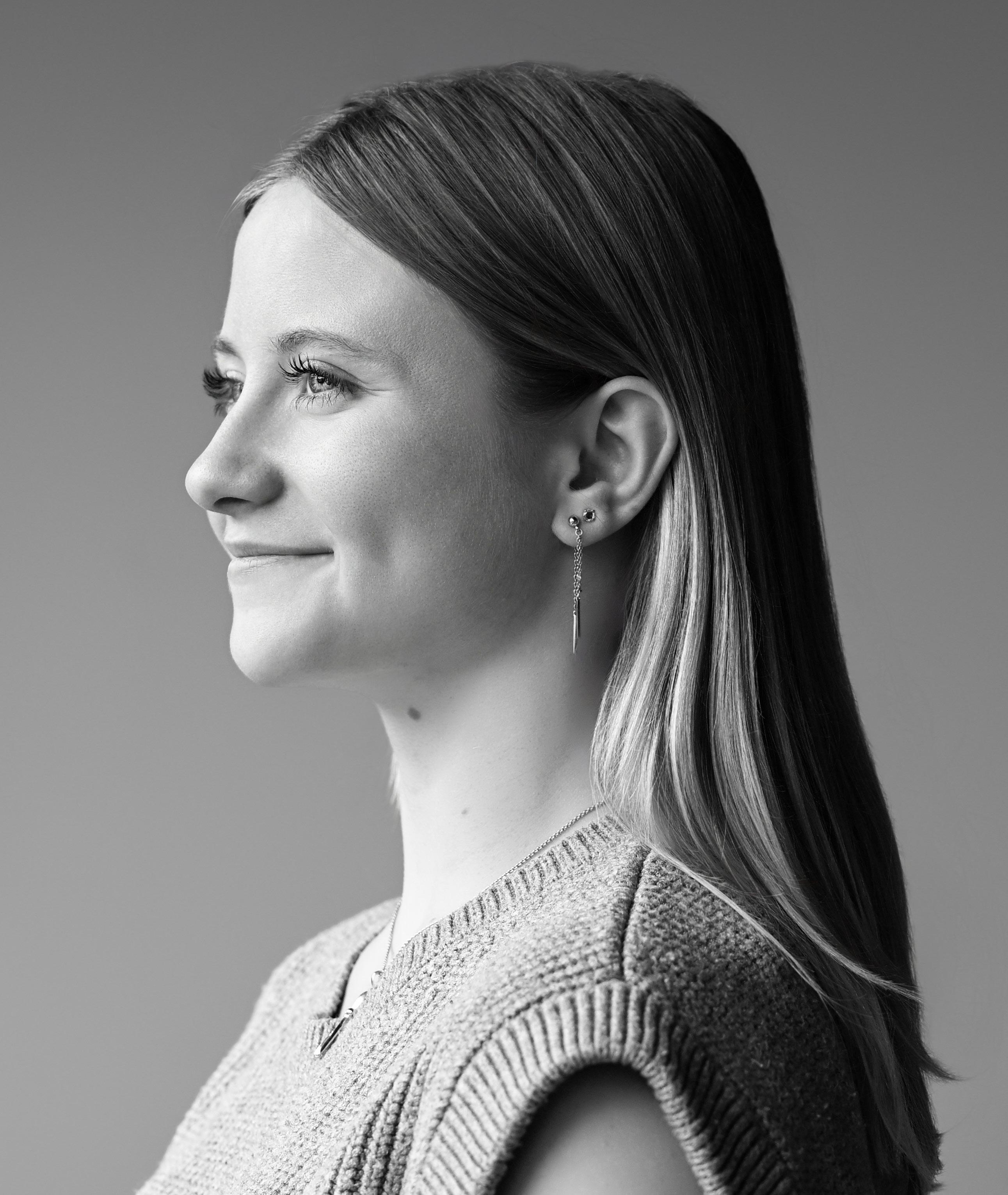
On any given day across the Seton Hall campus, members of our community live out the Catholic faith in myriad ways. They attend daily Mass in the Chapel of the Immaculate Conception. They gather for weekly Bible study. They attend Thursday night events organized by Campus Ministry. And they spread out across New Jersey and around the globe on mission trips that hearten those most in need of a helping hand.
We set out to chronicle how faith comes alive at Seton Hall. This is what we found.
As a high school senior, Kennedy Dierks ’23 had already committed to UCLA, a public university with more than 45,000 students in her hometown of Los Angeles. But in the spring of her senior year, she met an admissions counselor from Seton Hall, and she agreed to fly across the country and visit the campus in South Orange, 2,500 miles from home. The impact was immediate.
“As soon as I stepped on campus, I felt like I was home,” she says. “I can’t explain it, except that I’m convinced that it was God working in some way in my life.”
Dierks visited campus on April 29, which meant she had 24 hours to make a decision. She committed to Seton Hall from her hotel room before boarding her flight home.
Once enrolled, she gradually found herself attending Mass regularly and getting involved with Campus Ministry. Two study abroad trips to Italy, organized by the Office of International Programs — “Following in the Footsteps of the Saints” in 2023 and “Foundations of Christian Culture” the following year — proved essential to her academic career and her faith journey.
She was also influenced by the priests she encountered on campus. “It was the first time I’d ever seen young priests,” she says. “One thing they all have in common is they are real people. I have been really lucky to see the humanity of these priests. They connect with students in and outside the chapel, try to know us, who we are as people.”
Dierks graduated in 2023 with dual bachelor’s degrees in biology and Catholic studies. This fall she is scheduled to receive her master’s degree in health administration. Recalling her unlikely pivot on her path to college, she says: “I made a plan. I knew what I was doing. And then God laughed at me and said, ‘Here’s Seton Hall.’”
KAYHLYNN DICKEY
“When I came to Seton Hall,” Kayhlynn Dickey ’27 says, “I was not religious.”
Her family had shifted among different Protestant faiths, Dickey says, in between what she calls “periods of no belief.” In fact, as a high school senior, Dickey felt disinclined to apply to Seton Hall once she realized it was a Catholic university.
But her first year at Seton Hall brought her into contact with Campus Ministry. She began attending its Thursday night events — a barbecue one week, a cornhole tournament the next — and making new friends in the process. Her University Core courses helped her learn about faith — and about opposing opinions.
She encountered God, she says, “in a very deep and real way,” and found many people on campus, religious and otherwise, who taught her about the world, about God and about herself. At the start of her first semester on campus, she could not bring herself to walk into the Chapel of the Immaculate Conception. “By the end of my first year,” she says, “I basically lived there.”

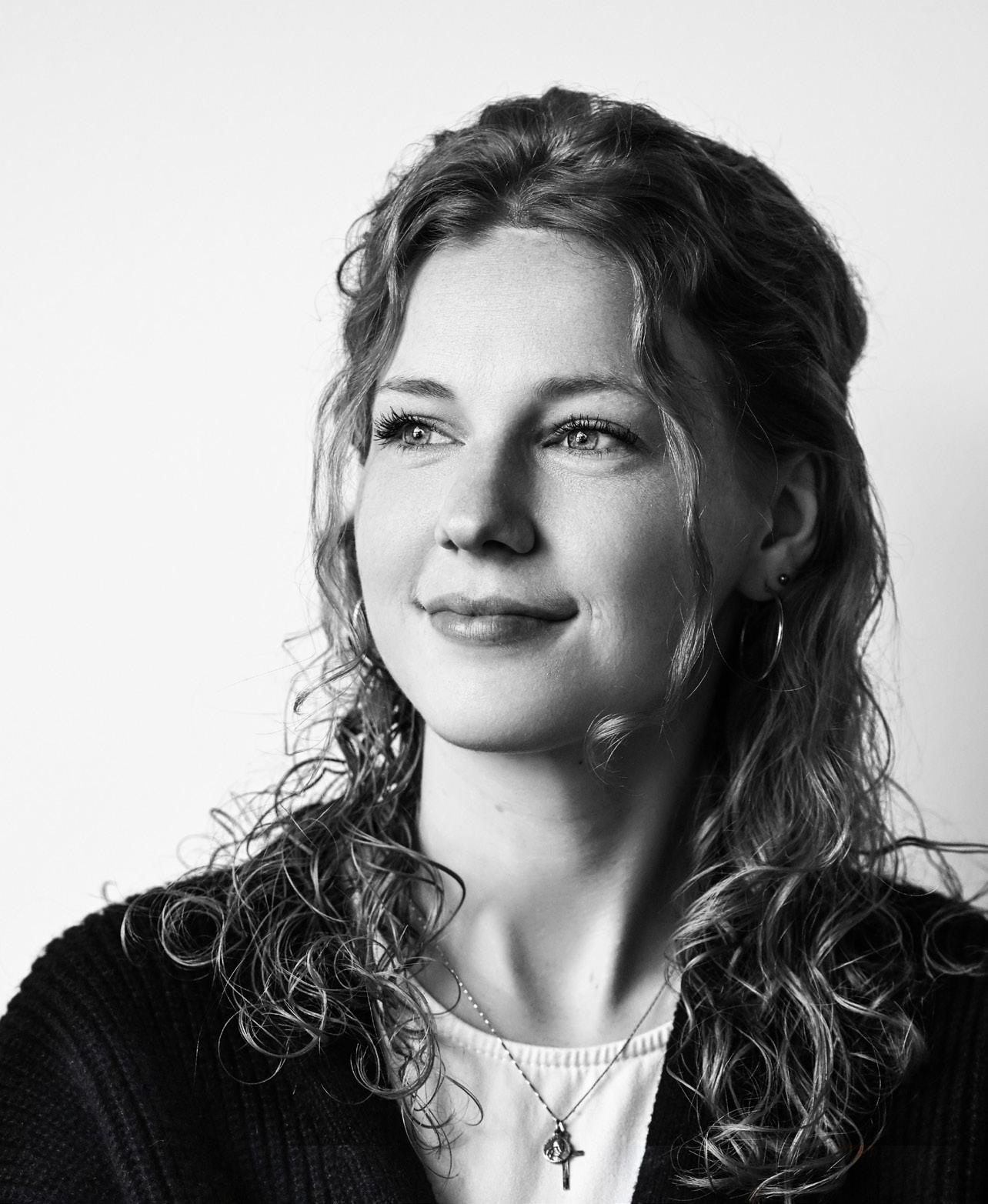
“I made a plan. I knew what I was doing. And then God laughed at me and said, ‘Here’s Seton Hall.’”
KENNEDY DIERKS

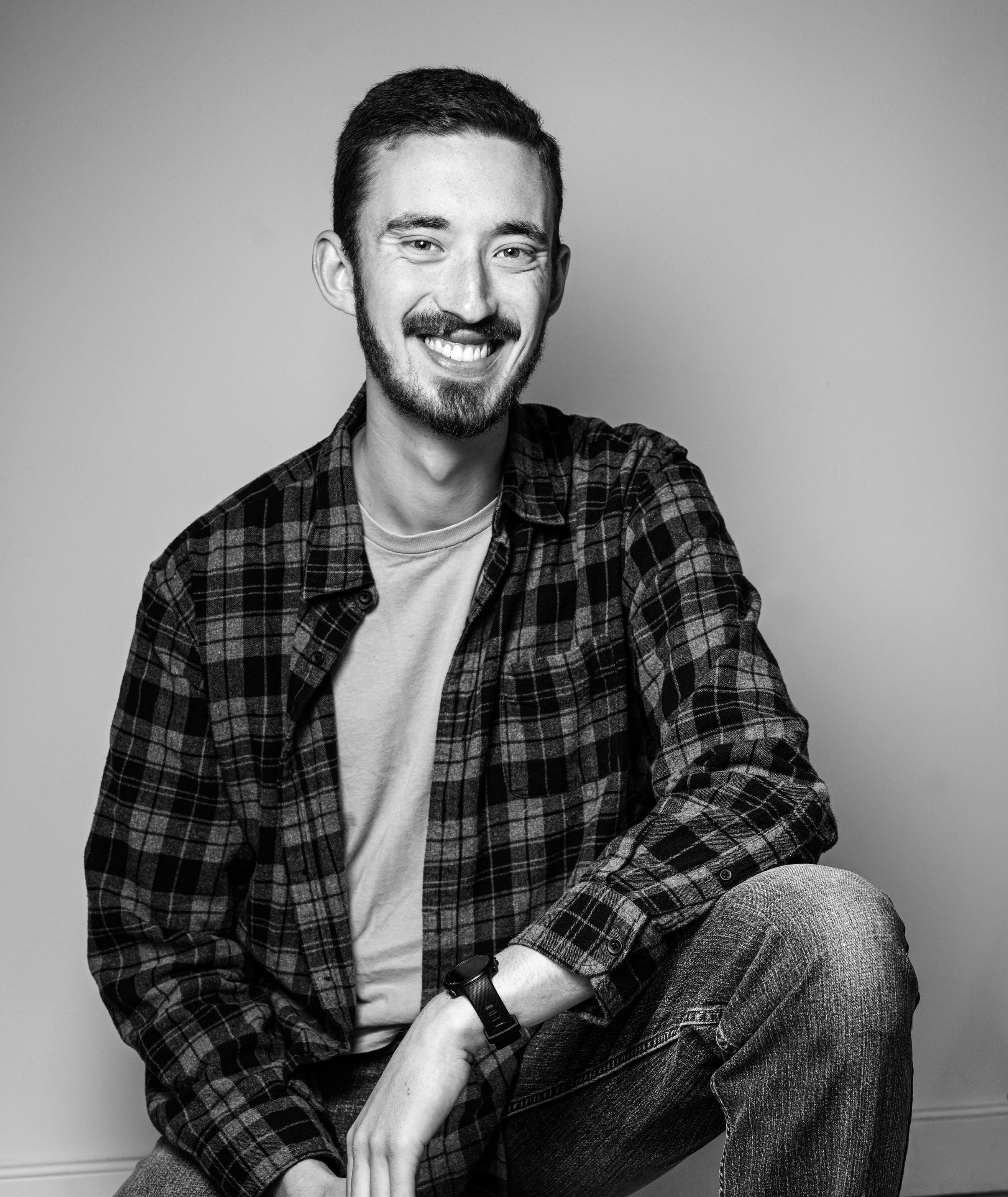
“It’s work that, when done right, and when done with the right heart, can yield a lot of fruits in others’ lives, but definitely in our own.”
TED REINHARDT
This spring Dickey was baptized on campus, having gone through the Order of Christian Initiation of Adults to become a member of the Catholic Church. Today, she’s working toward her bachelor’s degree in theology, with a minor in Catholic studies. She sometimes leads prayer groups and Bible studies, and she’s also part of the Campus Ministry support team.
“Seton Hall didn’t just play a role in my journey of faith. With the Holy Spirit, Seton Hall brought faith to me and then held my hand as I began to walk towards God. Seton Hall pulled me out of myself and helped me grow in ways I didn’t think were possible.”
Erich Sanders ’25 arrived at Seton Hall in the fall of 2021 having chosen to study Catholic theology, yet still unsure whether he had chosen the right college. His already strong Catholic faith had always made him feel like an outsider, even at his Catholic high school in northern New Jersey, and his closest friends had traveled far beyond the state to pursue their college careers. “In short,” Sanders says, “as I started my Seton Hall journey, I was worried that it really was not the place for me. Yet nothing could have been further from the truth.”
A friend introduced him to Campus Ministry, where Sanders found his footing and his people. “People really seemed to enjoy talking about things that I enjoyed talking about,” he says. “My freshman year in Campus Ministry helped me to open up and see that living my faith was not something which would sequester me but was instead a way of authentically engaging with the world.”
Sanders’ work on campus as a sacristan only deepened his connection to his faith. As a sacristan, he was responsible for preparing chapels for Mass twice each week — lighting candles, watering flowers, cleaning up. And his professors — Eric Johnston, an associate professor of undergraduate theology, was especially influential — helped him make connections between his academic life and his faith life. This fall he starts a joint master’s program in philosophy and theology at Boston College.
“The academic study of theology and philosophy helped me to grow in my faith,” Sanders says, “because it allowed me to come to a deeper and more intimate knowledge of the Church and her tradition, along with my place in it. The education I received in my degree program was not only of the mind, but of the soul.”
When he arrived at Seton Hall in the fall of 2022, Jonathan Wallace ’26 had no intention of getting involved with Campus Ministry. In his hometown of Plano, Texas, his parents had attended a Baptist church, then joined a non-denominational congregation. He considered himself a Christian, though not a Catholic.
Yet his freshman year found Wallace attending many events organized by Campus Ministry. In time he asked himself why he felt pulled to keep returning: “I concluded that it was because I wanted to be known,” he says. “And the intentionality that people would have whenever they would talk to me, it was pretty clear that they genuinely care about me and I’m not just a number.”
Wallace came to understand that the missionaries and priests and others he encountered through Campus Ministry were, he says, “here to show me the love Christ has for me.” It was a learning process, with many firsts — his first Mass, first Eucharistic Adoration, first time praying the rosary.
One day Father Nicholas Sertich, the director of the Office of Campus Ministry, asked Wallace if he ever thought about being Catholic. Wallace resisted, concerned about his parents’ response. But a two-week trip to Rome and Portugal in 2023, sponsored by the Community of Saint John and culminating at World Youth Day in Lisbon, proved pivotal. “That’s when I felt that desire to making this leap of faith,” he says.
When Wallace had his first Communion on campus in April, his parents and younger sister were in attendance.
“This year,” Wallace says, “my role has been about being that same mentor as many were to me and giving back the same love that others have shown me throughout my years here so far.”
SISTER ANGEL MARIE CAPDEVILLE, CAMPUS MINISTER,
COMMUNITY OF SAINT JOHN
“I work as a campus minister. Being the Order of Christian Initiation of Adults coordinator since 2021, I am especially dedicated to welcome all the students who have the desire to complete their sacraments or to become Catholic. There is a great awareness of God’s work acting in the hearts of these young people. I have been privileged to see how many students have been led by the spirit of the Lord to start their journey in the Catholic faith, but also to see them being transformed throughout the journey, and then become leaders in their faith within the community.”
FATHER JOHN FRANCIS, CAMPUS MINISTER, COMMUNITY OF SAINT JOHN
“My title is campus minister. I’m a listening ear for students, providing spaces for them to encounter each other and discover a life of faith. I work with people who are not only Catholic or Christian, but any student who wants to go deeper in their own journey, who needs support in one way or another. I very intentionally spend my office hours, if you will, all over campus and public spaces making myself available to students. We are in close contact with the kind of people whose faith journey is extremely alive — not only alive, but intentional.”
DYLAN LANOUE, CAMPUS MISSIONARY AND TEAM LEADER WITH THE FELLOWSHIP OF CATHOLIC UNIVERSITY STUDENTS (FOCUS)
“FOCUS missionaries work with Campus Ministry. The three parts of our mission are walking with the students in authentic friendship, divine intimacy — a personal friendship with Jesus — and what we call the little way of evangelization, which is formed after Saint Thérèse of Lisieux. Her way was investing in a very small number of people. It’s kind of modeled after Jesus. Jesus invested strongly in a few that affected many. At Seton Hall, the community has really boomed this year. The number of students who have been to Bible study at least once has almost doubled since last year.”
TED REINHARDT, MISSIONARY, SAINT PAUL’S OUTREACH
“I’m grateful to have come up here to Seton Hall and been on a mission these past two years. The Lord has opened my eyes to the challenge of evangelizing and spreading the Gospel. Sharing His word and sharing His love, that’s been the biggest theme of my time here. This is really good work. It’s hard work, but it’s work that’s necessary. It’s work that, when done right, and when done with the right heart, can yield a lot of fruits in others’ lives, but definitely in our own.”
“A Seton Hall missionary invited me on a mission trip the summer after my sophomore year to serve the homeless for a week, and it changed my life. I was able to see the Holy Spirit at work and was in an environment that was so pure and joyful that I could never forget. This mission trip brought me so much faith from my firsthand experiences of the Holy Spirit and left me with the knowledge that God has a lot in store for me. Following the mission trip, I began my own Bible study here on campus and began trying to live my life in the eyes of God.”
“I just kept asking questions, but nobody around me was really into faith or knew answers. I go to Mass one day with my friends, and Father Nick held up the Book of Gospels to do the Gospel reading, and I felt tears come in my eyes and my throat kind of get a little tired, like I’m about to start crying. I was just like, ‘What is this feeling? I was super-overwhelmed with feeling the love of God in that moment.’
“If I chose another school, there’s a chance I never would have found my faith or found these people calling me forward. In my eyes, in my heart, it was the Holy Spirit telling me, ‘Just wait a little bit, see what’s in store for you here.’” n
Christopher Hann is a freelance writer and editor in New Jersey.
“There is a great awareness of God’s work acting in the hearts of these young people.”
SISTER ANGEL MARIE CAPDEVILLE
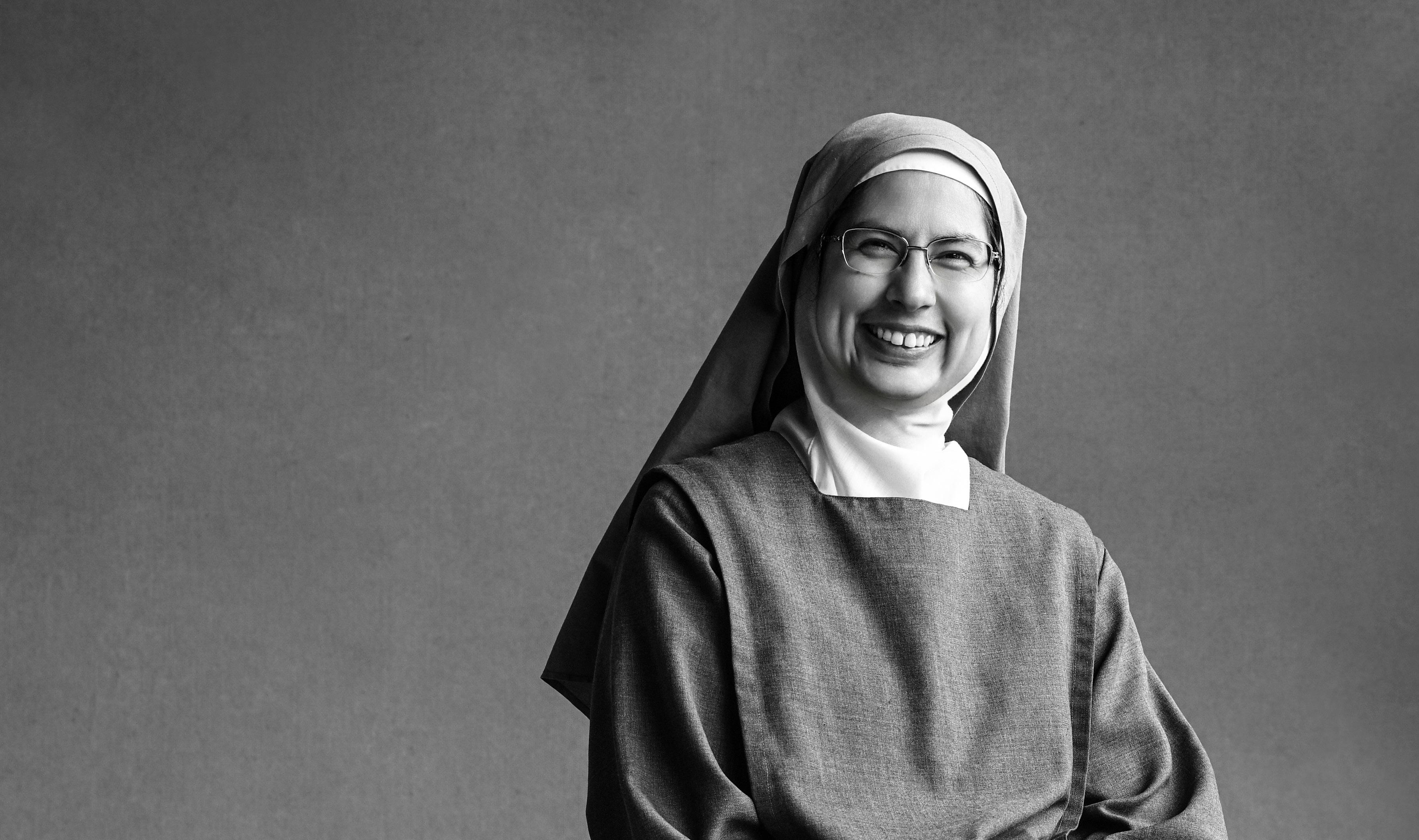
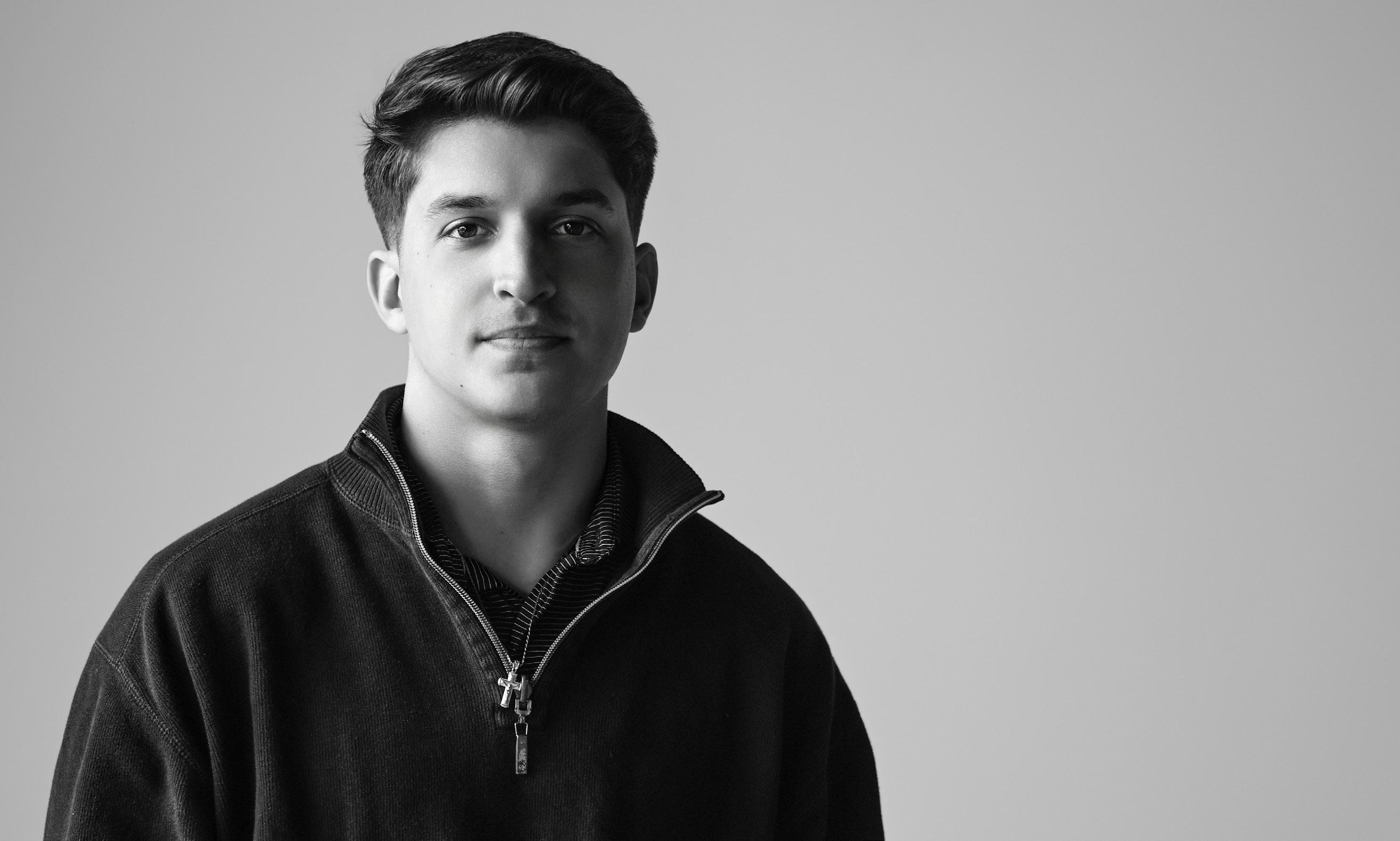
“This mission trip brought me so much faith from my firsthand experiences of the Holy Spirit and left me with the knowledge that God has a lot in store for me.”
The culmination of a 10-year journey to improve athletics facilities was unveiled this past winter when the Seton Hall Basketball Performance Center opened to student-athletes in February and enjoyed a ribbon cutting and blessing ceremony in March.
The Basketball Performance Center, which was supported through an incredible outpouring of private donations from the Seton Hall community, includes a new basketball court equipped with eight baskets,
locker rooms for student-athletes and coaches, a student-athlete lounge and dining area, offices and a conference room, a sports medicine suite, a strength and conditioning center adjacent to the court, an equipment room, a film room and more.
The entire facility is adorned with Seton Hall visual cues, and the main hallway pays homage to the Pirates of the past with a historical timeline of events that helped build Seton Hall Basketball into the national name it is today.
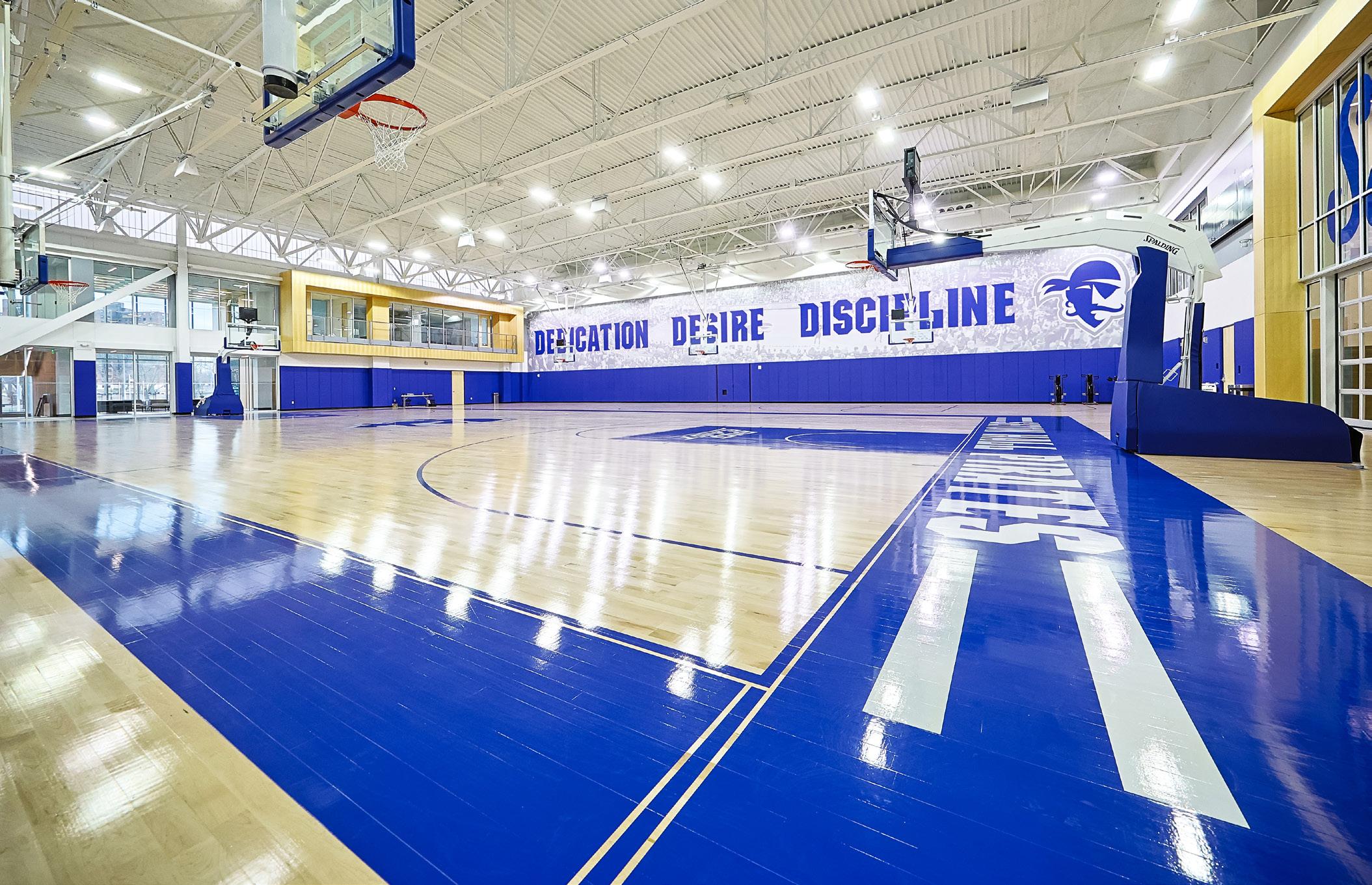
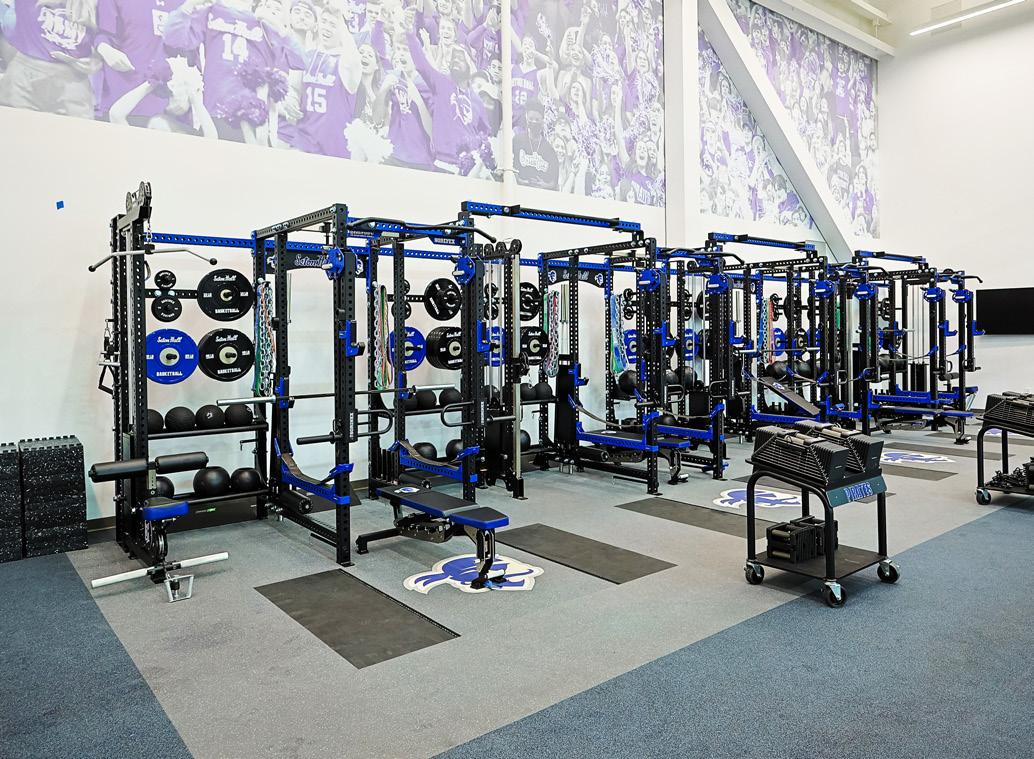
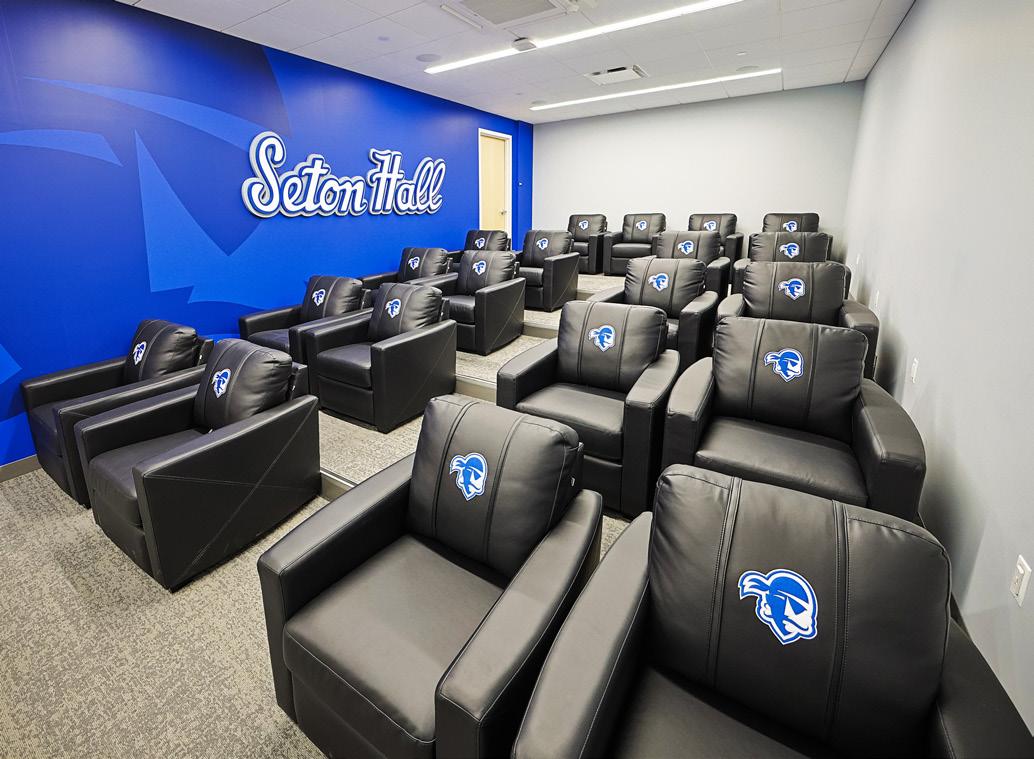


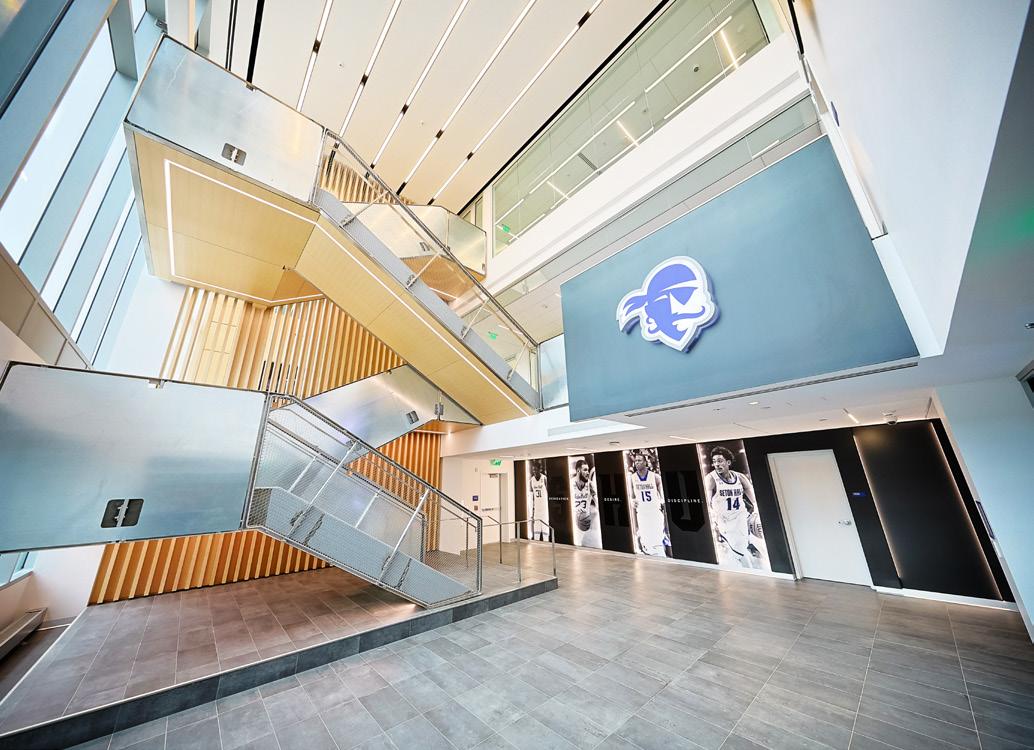

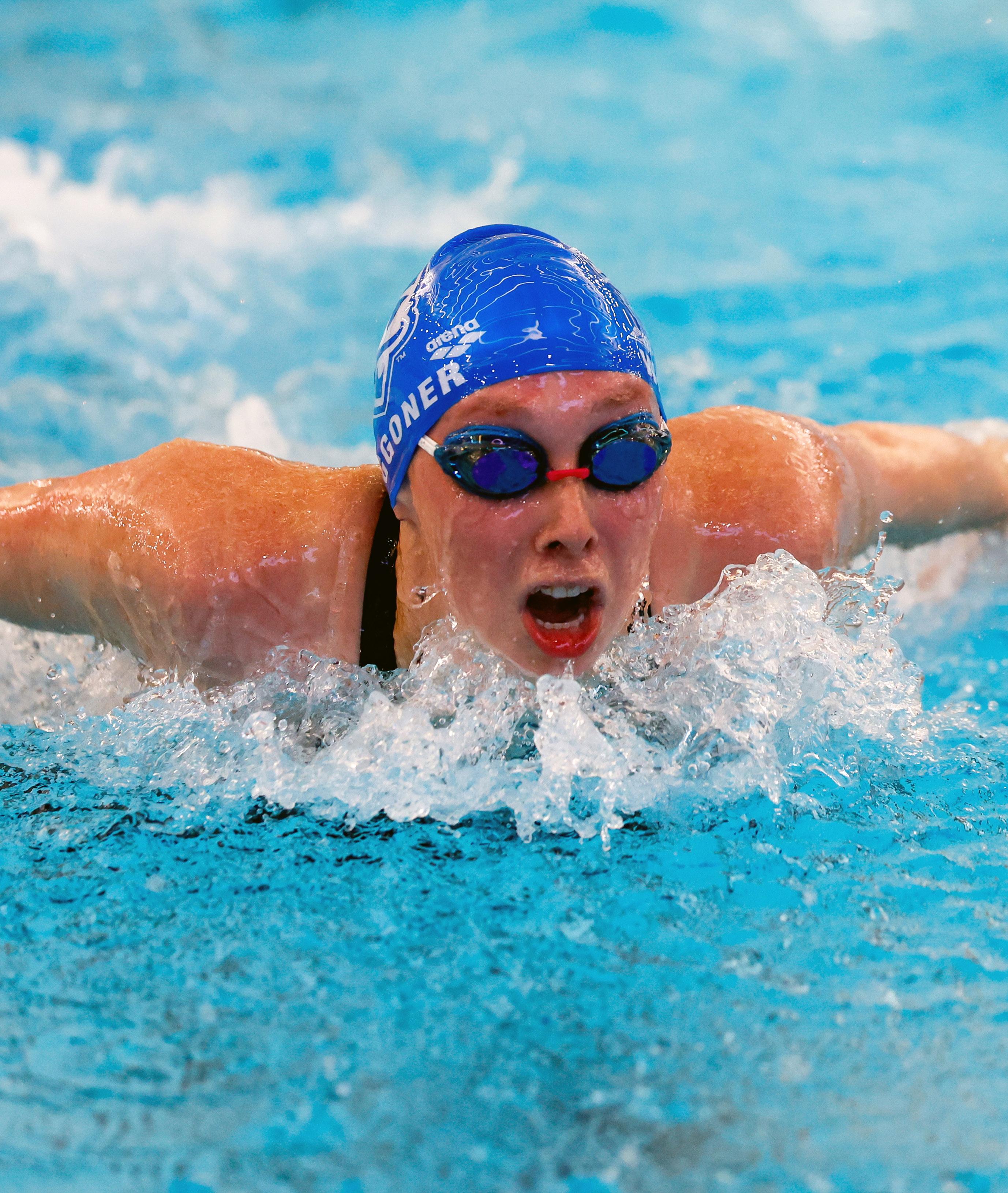
Alot of women have exploded off the starting blocks and into the pool since Seton Hall first formed a women’s swim team in 1978. There’s been no shortage of BIG EAST champions among them, either. But competing in the NCAA Division I Women’s Swimming and Diving Championships was always just out of reach.
That all changed this year, though, when Allie Waggoner got the news she would be the first woman to represent the Pirates at the national championships — in not one, but three events. The 22-year-old senior from Moorestown, New Jersey, qualified to swim in the 1650 freestyle, 500 freestyle and 400 individual medley when the country’s elite college swimmers squared off in Federal Way, Washington, on March 19–22.
As with many watershed moments in life, Waggoner remembers exactly what she was doing when head coach Derek Sapp broke the news: “I was eating breakfast at home when Derek texted me and the assistant coach, Andrew [LeBlanc]: ‘We made it — it’s official!’” Then she did what all true competitors do: she finished her meal and got herself to practice.
Waggoner’s achievement was the result of a yearslong commitment to keep improving her times, although it may have been a disappointment that gave her that little extra oomph to make it to the NCAA meet. “I just missed it my junior year,” she recalls. Instead of sinking under the weight of dashed hopes, though, she says, “I realized that if I kept training really hard over the summer, and putting the work in from the beginning of my senior year, it was definitely doable.”
Coach Sapp agreed, and was quick to assure her it wasn’t a pipe dream. He recalls telling her, “‘There is a very good chance, if you keep working the way you do, and keep doing what you’re doing, that you’ll make it’” to the NCAA championship meet. “She fully bought into it, and had the confidence in herself to keep pushing.”
Quiet confidence and a willingness to lead by example are traits that inspired him to tap Waggoner as team captain. It’s a style that suits her.
“I think that’s the best way to lead,” she confirms. “If you’re just telling someone to work hard and you’re not doing it yourself, what’s the point in that? When we’re in the pool, pushing each other, working on harder intervals — I’m doing that myself.”
Similarly, the reward for hard work extends beyond her own achievements to her teammates — and Seton Hall swimmers to come. “It’s awesome for the program. It shows, ‘Hey, look, we can do it,’” Sapp says. “You’ve got to find the right person that really believes in that and buys into it. Maybe this is cliché, but Allie gets it and understands it.”
The idea that her accomplishments could have a lasting, positive effect on her team and on Seton Hall is, in fact, its own reward to Waggoner. “The swim team, the athletic department, the school in general, have given me so many opportunities. To be able to do this and kind of give back — it means a lot.”
While she may have touched the wall for the last time as a Pirate, Waggoner’s not done competing. This summer she hopes to take part in the U.S. trials for the World Championship, and also keep “giving back” by sharing what she’s learned with younger swimmers as a teacher and a coach.
Come August, Waggoner will embark on her postcollege life by putting her newly minted degree in communications, with a minor in public relations, to good use in a year-long postgraduate internship with Disney. And she’ll do it with the satisfaction of having set a new standard, on a national stage, for the community she found in South Orange.
“That was something I really wanted for myself, my teammates and my coaches,” she says. “But, also, that was something I also really wanted for Seton Hall.” n
The memory of longtime Pirate fan Robert J. Higgins ’51 was honored at a family reunion during a Seton Hall women’s basketball game in Walsh Gym in December. The 20-member group met with Coach Anthony Bozzella and the players before the game. The gathering served as a tribute to Higgins’ memory as well as the group’s shared experiences as students and alumni.
Joseph M. Deehan ’66 published Unlocking the Vault, a collection of poetry and prose reflecting on his ancestral ties to Ireland, his New Jersey roots and his years in the Blue Ridge Mountains. Proceeds from the book will be donated to the Parkinson’s Foundation.
Joseph F. Duffy ’72/M.A. ’77 is a volunteer puppy raiser for The Seeing Eye guide dog school, preparing dogs for their specialized training and eventual pairing with blind individuals. Duffy and his wife are now raising their eighth puppy. Maureen Conroy Tauriello ’75, a writer for Extraordinary Catholics magazine, planned and performed music at the Convocation of the American National Catholic Church in August. She also co-hosts The Sonic Boomers podcast with her husband, Peter J. Tauriello ’76. Roger B. Newman ’76 celebrated the publication of his novel, Boys, which was featured in Publishers Weekly. The story is about young men of different races raised as brothers in North Carolina during the Great Depression. Thomas P. Oppel ’76 was elected to the New Hampshire House of Representatives last fall. A Democrat, he represents the towns of Canaan, Dorchester and Orange.
Darrell W. Gunter ’81 was a contributing writer on a book by librarian Katina Strauch titled Doing the Charleston: My Personal History of Scholarly Communication, being published this spring. Michael DeMarco ’82 published his sixth book,
To Give to the Light, a biographical novella about family life, surviving world wars, immigrating and adapting to a new culture. Arthur S. DeGroat, Ed.D. ’85 celebrates his 25th year in higher education as the founder and executive director of the Office of Military & Veterans Affairs and the Military Affairs Institute at Kansas State University. A specialist in helping veterans transition to the workforce, he advises the governor of Kansas and the U.S. Senate Veterans’ Affairs Committee. The Department of Defense has recognized him for using performing arts to support combat veterans and their families. James M. Porfido ’85 published his first book, Unequal Justice: The Search for Truth to Balance the Scales, which reflects on his 35 years of being a criminal attorney for both the prosecution and defense in high-profile cases. Dawn L. Milstrey ’86 is the author and illustrator of The Stone Angel Society, a series of illustrated short children’s ghost stories highlighting the importance of friendship, kindness and teamwork. Joseph J. Pisauro ’88/M.A.M. ’96 and his wife, Nancy, were honored by the Diocese of Paterson with the Vivere Christus Award, presented by Bishop Kevin J. Sweeney at a prayer service at the Cathedral of Saint John the Baptist in Paterson. Nominated by their pastor, Father Joe Garbarino, the couple was recognized for their service to the Saint Ann Parish Community in Parsippany.
Jennifer L. Walter ’92, vice president of accounting and tax at Sol Systems, is an advocate for renewable energy, and leads local and national projects for sustainability. Thomas Duffy ’92 and The Duffy Group at Merrill Lynch have been named to Forbes magazine’s/Shook Research’s Best-In-State Wealth Management Teams (New York) for 2025. Andrea L. (Cammarato) Van Benschoten ’92 is the author of the recently published Italians of Newark: A History Vincent Auteri, Jr. ’95/M.P.A. ’99 was promoted to detective captain of the criminal investigations division of the Lyndhurst, N.J., Police Department. Barbara E. Sargent, Ed.D. ’97 recently retired as superintendent of the West Morris Regional High School
District and was named Morris County Superintendent of the Year (2024-25).
Patrick J. Antonetti ’00 was re-elected to the Lincoln Park, N.J., Borough Council. Richard B. Hall ’00 was appointed chairman of the board for Hunterdon County Crime Stoppers. Jeanette Pine ’03 was recognized as Teacher of the Year at Watchung Elementary School in Middlesex, N.J. Michelle J. Marose ’03, a partner at Meyerson, Fox & Conte, was sworn in as a judge of the Superior Court in January. She has been assigned to the Passaic County of New Jersey Family Part Division. Kristen Mroz ’05 has been certified as a Division of Fire Safety Level II fire instructor and appointed as the battalion chief for Hazmat Response Solutions in Atlantic City. Ryan J. Weir ’06 has been elected to the partnership and as a firm leader at CohnReznick LLP, an accounting, advisory and tax firm. C. Eduardo Vargas Toro ’07, Lucas E. Rubio J.D. ’24, Eric Gallant J.D. ’24 and Jacob V. Hudnut, J.D. ’10 graduated from the Army School of Infantry’s direct commission course at Fort Moore, Ga., in February. Kenneth Gaines ’08 published a book, A Call to Worship, a journal of the trials, struggles and triumphs of his life.
Heidi M. (Boon) Mitchell, M.A.D.I. ’11, was named one of Winderweedle Law Firm’s Best Lawyers in America for 2025. Taylor M. Cain ’18 was honored with the 2023 Federal Emergency Management Agency’s Administrators Team Award for Readiness last year. Vanessa E. Smith ’19 was honored with the $25,000 Milken Educator Award at her school in Charlotte, N.C. The award recognizes the top 1 percent of educators nationwide each year, celebrating excellence and innovation in education.
Mindi R. Zudekoff ’21 has joined McGlinchey Stafford as an associate in the law firm’s financial services litigation practice in New York City.
Diplomacy has become second nature to Wendy Ekua (W.E.) Da’Cruz ’12/M.A./M.P.A. ’15 in all facets of her career: as entrepreneur, consultant and mentor.
So has versatility: Da’Cruz, who has Seton Hall graduate degrees in diplomacy and international relations as well as public administration, worked as a consultant for the United Nations Economic Commission for Africa in addition to launching two businesses. (She studied creative writing and business administration as an undergraduate.)
Da’Cruz earned the nickname “The Digital Diplomat” in 2016 as cofounder of the Virtual Global Consultant (VGC) Group, working to promote the use of technology to drive economic development. VGC helps clients worldwide adopt digital processes to find new revenue. Later, in 2020, she took on the role of food innovator, when she and her husband, Dominique, started a food business after Wendy took a trip to Malawi, where she was served a chickpea meatball. That culinary experience led her to investigate and develop alternative meat products through Mushroom Angel.
The company produces whole foods — like burgers made from mushrooms — and was created partly to develop better eating habits for herself and her family and to respond to the scarcity of fresh food in Detroit, where her family now resides.
Mushroom Angel’s mission, Da’Cruz says, is to provide impact locally and build globally; the firm contributes to economic development and job creation in the Detroit area.
“When I think about the Mushroom Angel Company, I think about food diplomacy. Everything for me comes down to diplomacy,” she says.
Da’Cruz says her faith came into play when she and her husband moved their family to Detroit to start a new life, and then when they started Mushroom Angel. “It took us four years to really understand why we believe God brought us to Michigan,” she says.
Although her path to success has provided plenty of twists and turns, Da’Cruz credits Seton Hall for her years of personal and professional development. While working as a graduate assistant in Public Relations and Marketing, Da’Cruz discovered how to be an effective communicator, and she says the lessons she learned in the classroom are still important in her business career today.
She notes that her mentors allowed her to grow both academically and personally, adding value and providing advantages to her as both a business owner and a mother.
Looking to the future, she is in a doctoral program at the University of Michigan, and hopes to pursue another venture, training corporate presidents and CEOs in global leadership.
“I want to leave this world empty of every gift that God has given me.” | ZACHARY COONEY
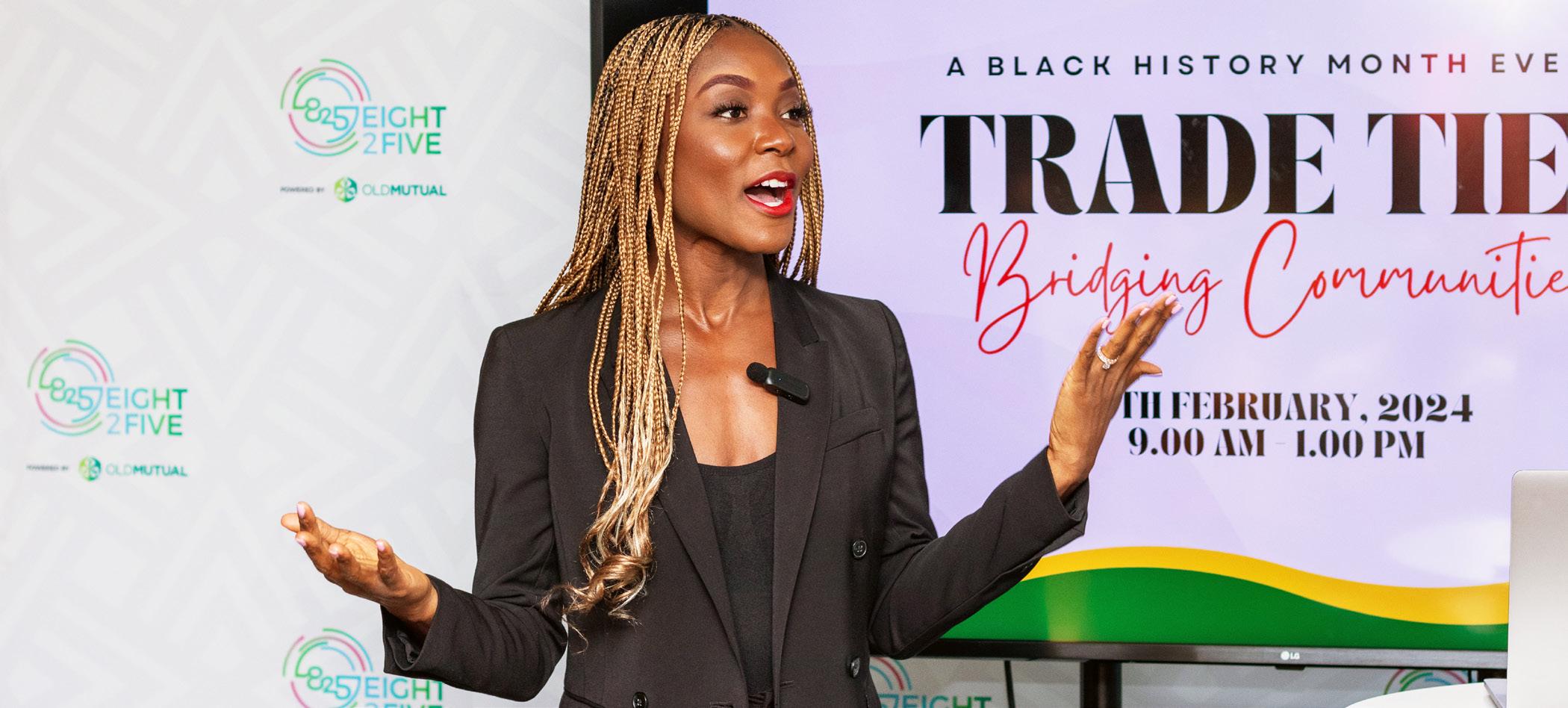
Rita M. Langan ’41
William H. Loftus Sr. ’42
Stephen Nagy ’42
Father Edward J. Nester ’42
Monsignor William J. Haughney ’43/ M.Div. ’47
John P. Kaelblein ’43
Thomas J. De Triquet ’44/M.A. ’82
Clotilde O. Fiore ’46
William P. Cunniff ’49
Frank N. Paparello ’49
Eugene Tarne ’49
Harry O. Bright Jr. ’51
Sophocles Gakos ’51
Joseph T. Reihl ’51
Richard J. Sauerwein ’51/J.D. ’59
Anton H. Sutto ’51
Eugene E. DeVito ’52
Stanley Bestys ’52
John J. Desmond ’52
John M. Doody ’52
Vincent D. Gautieri ’52/J.D. ’55
Raymond A. Grimard Sr. ’52
John W. Groome ’52
John J. McGuire ’52
Marius R. Moran ’52
Thomas J. De Rosa ’53
George M. DeTitta ’53
Dr. Charles E. Dooley Jr. ’53
Bernard J. Quinn ’53/J.D. ’56
Maria A. Coelho ’54
Col. Robert M. Keegan ’54
Joseph E. Museck ’54
Dennis J. Tallagnon ’54
Dr. Anthony M. Policastro ’55
Peter W. Henderson ’56
Robert F. Whirty ’56
Father Richard McDonald ’57
Timothy J. O’Callaghan ’58
Joseph M. Pitocco ’58
Vincent J. Muccione ’59
Raymond D. Aumack ’59
Dr. John M. Dear ’59
Monsignor Kenneth J. Herbster ’59/ M.Div. ’77
Gerald J. Kelly ’59
James F. McCarthy ’59
Edward M. Schell ’59
Eugene G. Schildknecht ’59
Joseph T. Williams ’59
Alfred A. Arnold ’60/J.D. ’63
John J. Kane Jr. ’60
Archie E. Mitchell Jr. ’60
Jeanne M. Waleski ’60
Frank P. Bozza Jr. ’61
Patrick J. Burns Jr. ’61/Ed.D. ’90
Diane L. Chapdelaine ’61
Maureen J. Dienes ’61
John A. DiNapoli ’61
William H. Hagerty Jr. ’61
Barbara P. Jaworski ’61
Robert D. Laib ’61
William J. Lewis Jr. ’61
Robert J. Ricci ’61
Father Francis E. Schiller ’61/J.D. ’79
Sister Helen Paul ’62
Gerald A. Cerza ’62
Michael H. Lasko ’62
Eugene R. Lear ’62
Patricia McLoone ’62
Father William J. Melillo ’62/M.Div. ’77
Nicholas J. Mongiardo ’62
Peter J. Anderson ’63
Sister Teresa R. Confroy ’63
George J. Kresge ’63
Vincent A. McGrath ’63
John F. O’Callaghan ’63
Frank J. Dincuff ’64
Charles R. Guariglia ’64
Kevin E. Hennessey ’64
Father James J. Reilly ’64
Thomas J. Slattery, III ’64
Irene M. Strumski ’65
Henry A. Bayard ’65
Clement J. Bianchi ’65
Sister Carmelita Boyd ’65
Harold R. Carnathan ’65
Angelo F. DiOrio ’65
Leo J. Finnegan Jr. ’65
Elizabeth S. Freeman ’65
Joseph S. Guglielmo ’65
Joseph C. Hourihan ’65
Thomas A. Kennedy Jr. ’65
Carol J. Landrigan ’65
Stephen N. Langway ’65
Richard Mandel III ’65
Frank S. Orbe ’65
Sister Mary C. Wszolek ’65
Joseph K. Fitzgerald ’66
Douglas J. Sajewich ’66
Walter J. Woodhull Jr. ’66
Kenneth G. Booth ’67
Terence G. Connor, J.D. ’67
Sister Stella M. Craven ’67
Nicholas F. Delmonaco ’67
Leo J. Gildea ’67
Robert Gordon ’67
Sister Mary P. Peters ’67
Stephen D. Porada ’67
Catherine T. Ruby ’67
Matthew R. Bocchino ’68
James A. Cella ’68
Thomas M. Combs ’68
John D. Deignan ’68
Jane Miller Dowling ’68
Dr. Robert E. Rinaldi ’68
Justin H. Tharaud ’68
Henry L. Pomerantz ’69
Phoebe F. Greenfield ’70
Bruno J. Verducci ’70
Anthony J. Romano Jr. ’71
Dennis Tarantino ’71
Joseph F. Hegedus Jr. ’72
John J. Kot ’72
Sister Eileen Martin ’72
George J. McElroy ’72
William P. Murtha ’72
Jerome F. O’Brien ’72/J.D. ’75
John A. Trucillo Sr. ’72/M.A.E. ’75
John F. Walsh ’72
Lloyd B. Long ’73
Kevin M. Prongay, J.D. ’73
Daniel Sommers ’73
William T. Morse ’74
Mr. John C. Ricker ’74
Charles Ducate ’75
Gregory K. Judge ’75
Grace-Ann Meyn ’75
Ronald Pihokker ’75
Jay J. Ziznewski ’76
Gary Ciuba ’77
Barbara Stracco ’77
Willie J. Williams ’77
Mary Arnold ’78
Frank McCann ’78
Father John Pierce ’78
Michael Romeo ’78
Susan Rumpf ’78
Richard M. Trimble ’78
John F. Costa ’79
Joseph T. Cancelliere ’80
Bill C. Giallourakis ’80
Gregory Lucas ’80
Michael Pontoriero ’80
Richard W. Tkach ’80
Michael Wilson ’80
Janis A. Wolfe ’80
Jamelle C. Hoskins-Nnakwe ’81/ M.A.E. ’88
Donald L. McBee ’81
Christopher J. Carey ’82
Mary McCormick ’82
Lawrence S. McDougle ’82
Patricia M. Rogan ’82
Lennie Seaman ’82
Barbara Sondej ’82
Linda Vanduren ’82
Richard J. Delello ’83
Sister Mary E. Harnett, O.P. ’83
Michael J. Madsen ’83
Anthony Rodriguez ’83
Linval A. Francis ’84/M.S. ’87
David J. Unterwald ’84
Joseph K. Ward ’84
Mark Kolibas ’85
Gerald A. Tobin ’85
Marianne B. McConnell ’86
John Mistretta ’86
Dr. Andrea Barbier ’88
Nyla C. Marshall ’88
Prince M. Licorish ’89
John A. Orlando ’89
Elizabeth A. (Lowney) Conlon ’90
Michael A. Amato ’90
Glenn Barry ’90
Linda S. Hanwacker Groschadl ’90
Carol J. Kiernan, M.A.E. ’90
Charles W. Rucinski ’91
Jo Ann Cucolo ’94
Stephen C. Reilly ’94
Father Thomas J. Major ’95
John P. Moricz ’95
Sister Joan L. Roccasalvo ’95
Patricia Dixon, M.A.E. ’96
Christopher P. Masciale ’96
Kathryn C. Strom ’96
John F. Hills ’97
Michael G. Picariello ’97
Barbara L. Gould ’98
John F. Ellard Jr., M.A. ’00
Eugene C. Pawlowski ’00
Felix A. Fofie, M.A.D.I. ’04
Jeffrey A. Burke ’07
Robert P. Yost ’08
Susan M. Rigo ’09
John C. D’Andrea ’10
Christopher J. Fiorenza ’11
Nellie Sun ’12
Stephanie M. Santora ’17
Carter A. McIntosh ’18
Mary H. Flanagan ’19

Father Lawrence Frizzell, S.T.L., S.S.L., D.Phil., died April 29, having served the Seton Hall community for more than 50 years as a specialist in Jewish-Christian studies and relations.
As director of the University’s Institute of Judaeo-Christian Studies, he was committed to encouraging the peace-building efforts of Jewish and Christian scholars, theologians, educators and students. He helped design the curriculum at the founding of the graduate program in Jewish-Christian Studies, which was the first of its kind and continues to serve as a model for eliminating prejudice through understanding.
“Larry was one of the Church’s most well-respected voices for advancing Jewish-Christian dialogue and understanding,” said Monsignor Joseph Reilly, S.T.L., Ph.D., University president.
In addition to directing the Institute, Father Frizzell was an associate professor in the graduate program, and his work also explored the impact of Biblical traditions on Catholic liturgy, prayer and ethics.
Born in Calgary in 1938, he grew up in Alberta and British Columbia. Memories of encountering anti-Catholic prejudice in his youth taught him to defend his faith while respecting others’ beliefs. He attended seminary for two years in
Edmonton before continuing his priestly training at Saint Paul Seminary in Ottawa.
He went on to study and teach in Rome and throughout Europe, Canada and the Holy Land, becoming fluent in many languages.
His first visit to Seton Hall was in 1969, attending a conference on Jewish-Christian relations. He joined the Seton Hall community in 1974 after earning a doctoral degree in England.
In 2008, Pope Benedict XVI named him Consultor to the Commission for Religious Relations with the Jews, an appointment renewed by Pope Francis in 2014. A year later, he received the Sister Rose Thering Holocaust Education Award.
A prolific writer, Father Frizzell also lectured widely on interreligious dialogue, including several presentations at the South Orange Public Library. He also wrote a column for The Catholic Advocate, the official newspaper of the Archdiocese of Newark, and moderated The Kinship of Catholics & Jews, a weekly radio program on WSOU.
A Vigil Service for Father Frizzell was held at the Chapel of the Immaculate Conception following a viewing, with a funeral Mass held the next day at Our Lady of Sorrows Church in South Orange, followed by interment in Maryrest Cemetery in Mahwah, New Jersey.
1. Mark Schild ’19 became a grandfather to a grandson, Leo Schild.
2. Mark Cantine ’10/M.P.A. ’12 and Anne (Touhill) Cantine ’10/M.S.N. ’17 welcomed their fifth son, Xavier John Cantine, on December 24, 2024.
3. Juleen S. Burke ’14 welcomed baby Christian Francis, on February 28, 2025.
4. Sean Pezza ’14 and Erin (Williams) Pezza ’14 welcomed baby Emilia Pezza.
5. Michael Cullen ’03 and Megan Namnama Cullen in 2024 welcomed a daughter, Olivia Marie, who was baptized in the Chapel of the Immaculate Conception by Monsignor Thomas Guarino, S.T.D.
6. Michael Starace ’16 and Elizabeth (Motta) Starace ’17 celebrated the baptism of their daughter, Alaina Oaky Starace, at the Chapel of the Immaculate Conception.

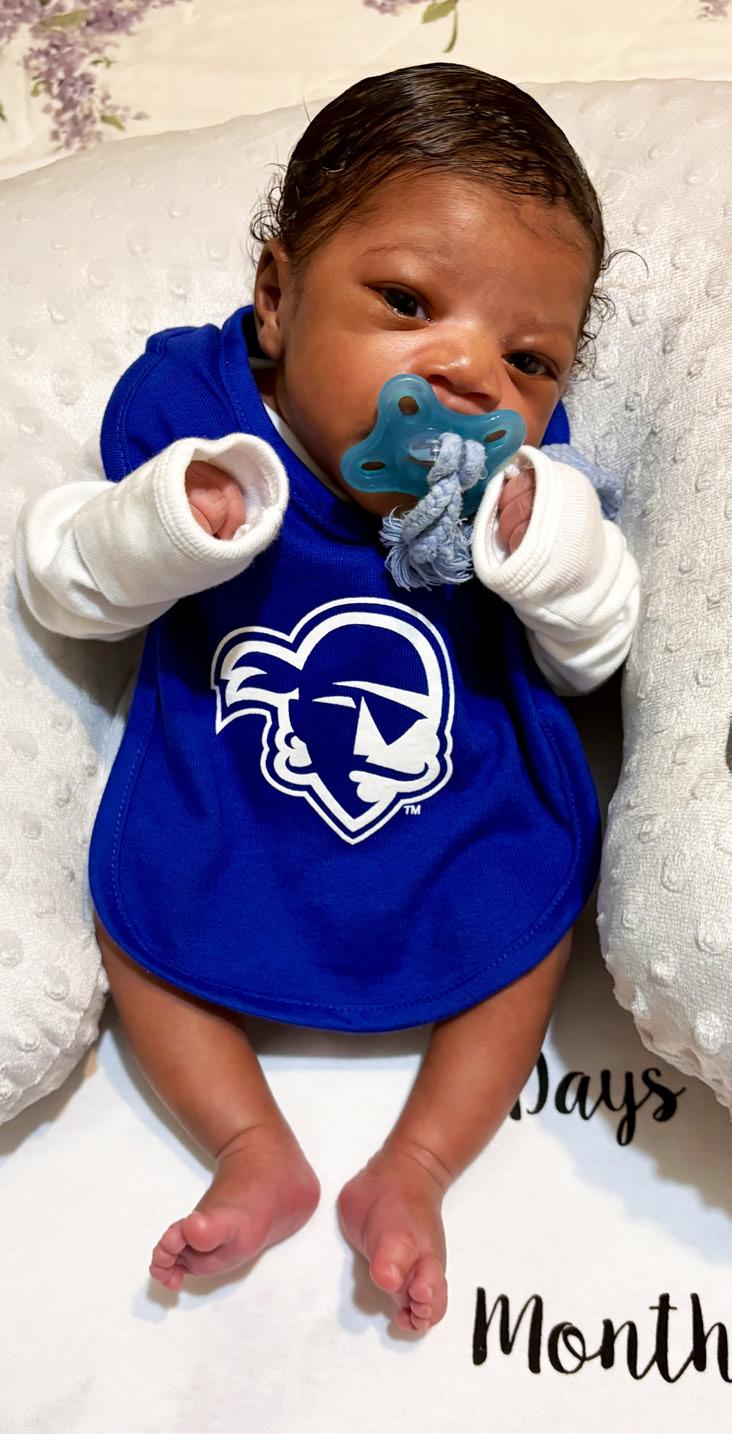
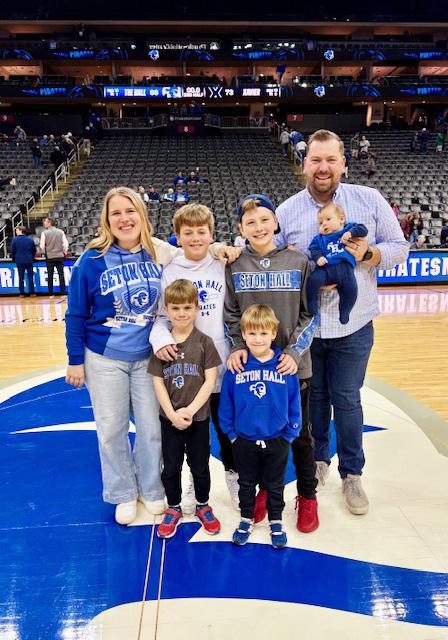

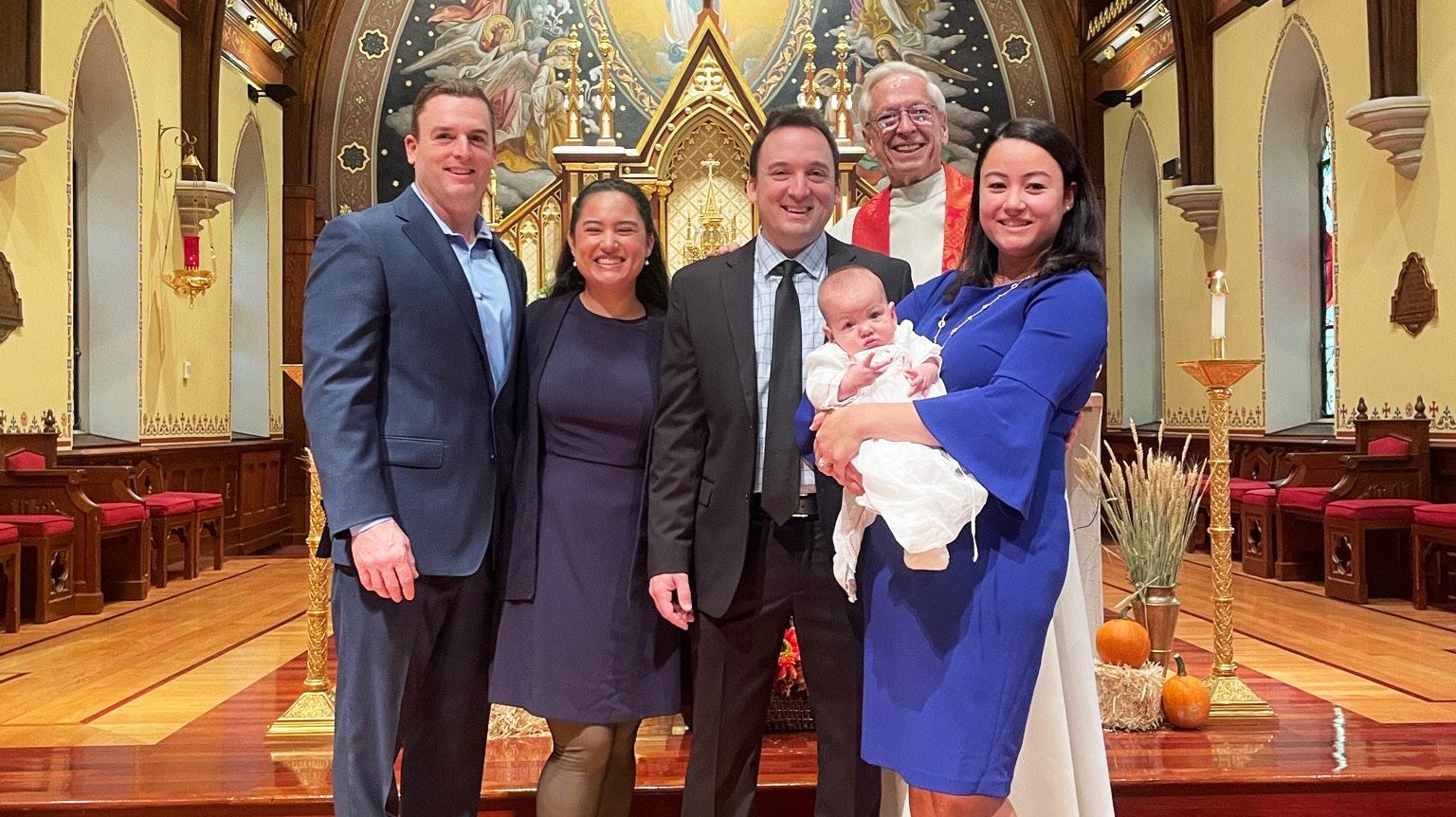
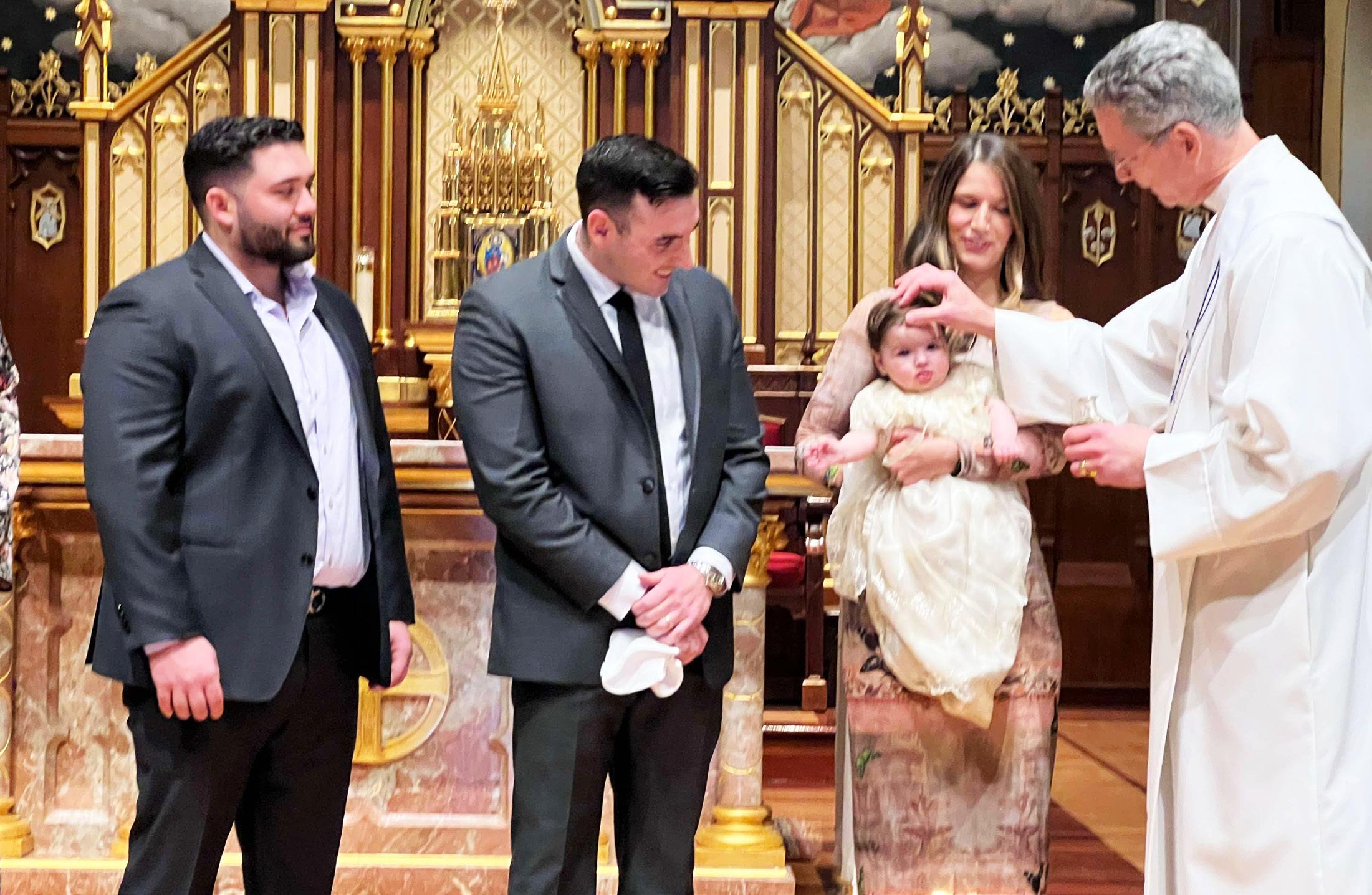
1. Gianmarco DeCastro ’10 and Stefanie (Clay) DeCastro were married at Saint Philomena Church in Livingston, N.J., on April 6, 2024.
2. Christopher Auer ’18/M.S. ’18 married Gianna (Santaniello) Auer on Dec. 22, 2024, surrounded by fellow Pirates.
3. Cherie L. (Johnson) Dolphin ’91 married Andrew Dolphin on Dec. 8, 2024, in Lewes, Del.
4. Mary (Saydah) Castro ’18/M.A. ’19, an adjunct professor in the Seton Hall College of Human Development, Culture, and Media married Jorge Castro Jr. ’20 at the Westmount Country Club in Woodland Park, N.J., on Nov. 22, 2024, with fellow Pirate alumni in attendance.
5. Dominick Alagna ’11 married Danielle (D’Ambrise) Alagna ’11 on Dec. 21, 2024, in Cape May, N.J.
6. Deana (Gifford) Brooks ’21 married Brandon Brooks on July 21, 2024, and received a special visit from the Seton Hall Pirate during the reception.
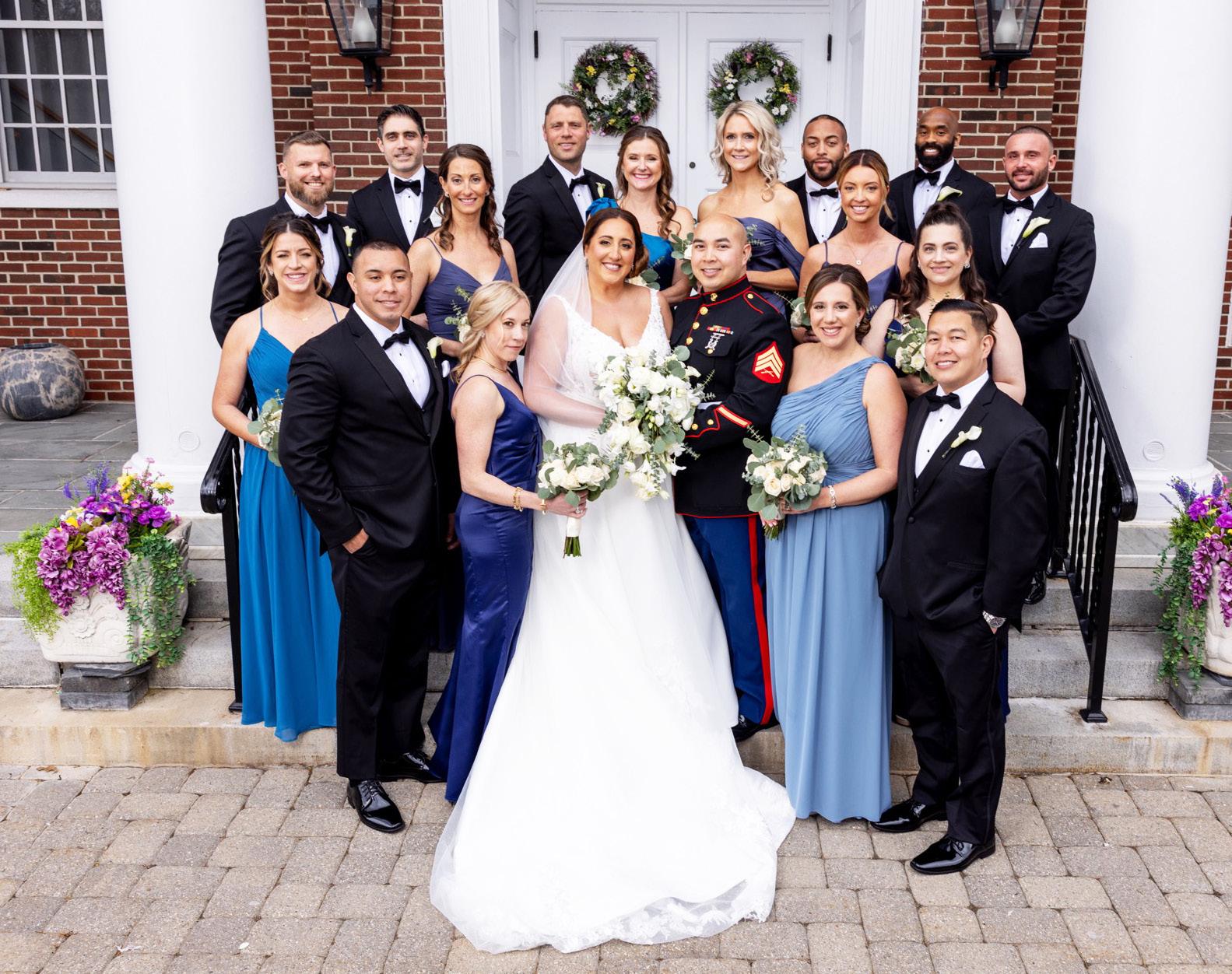
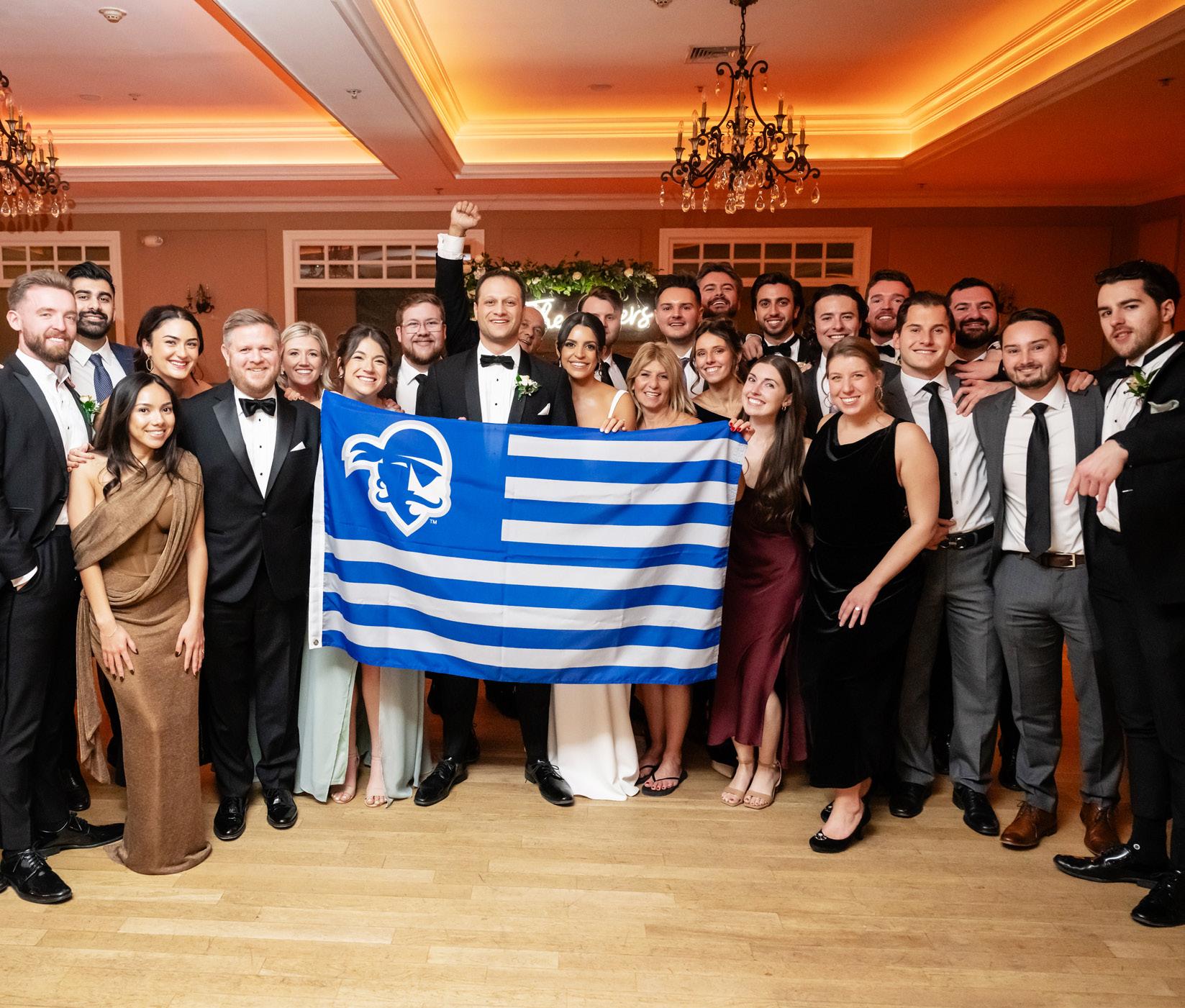
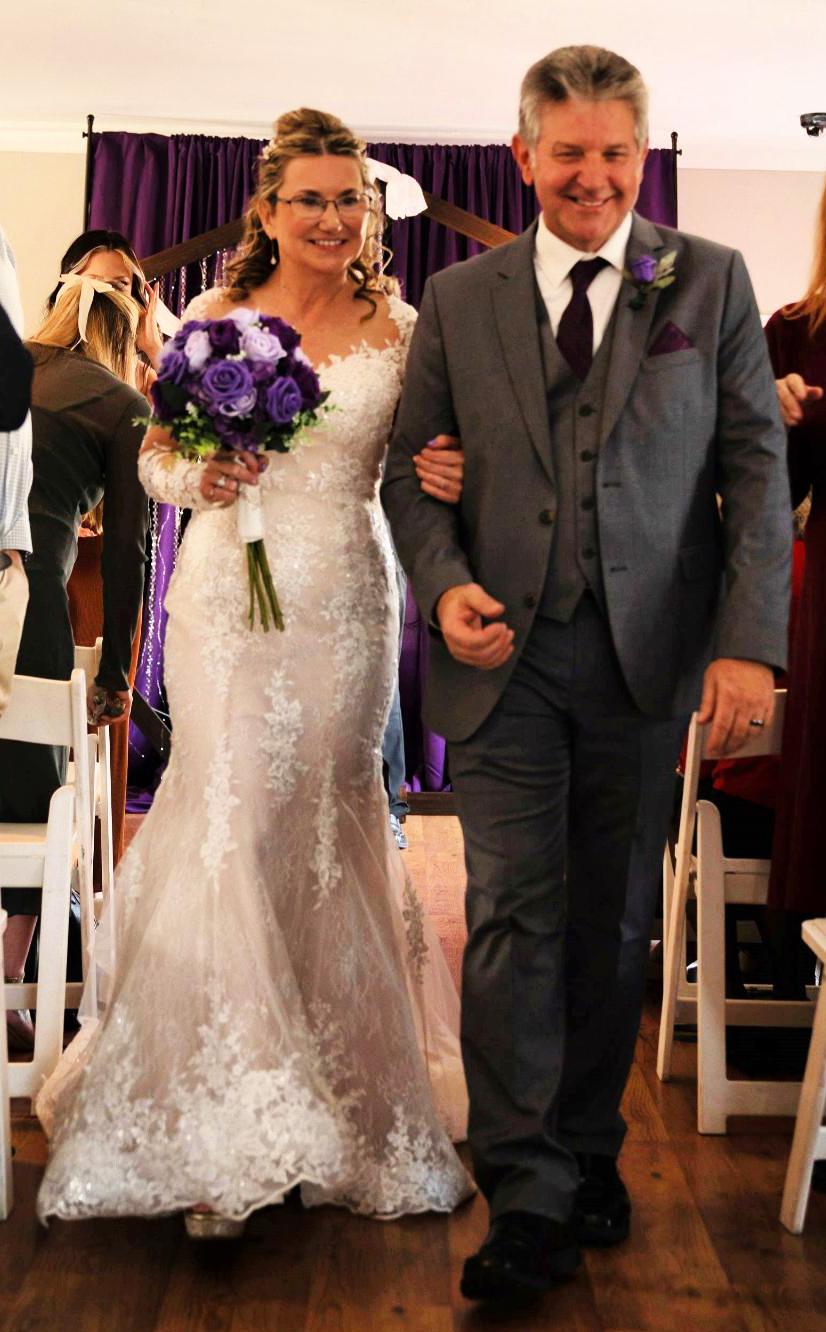


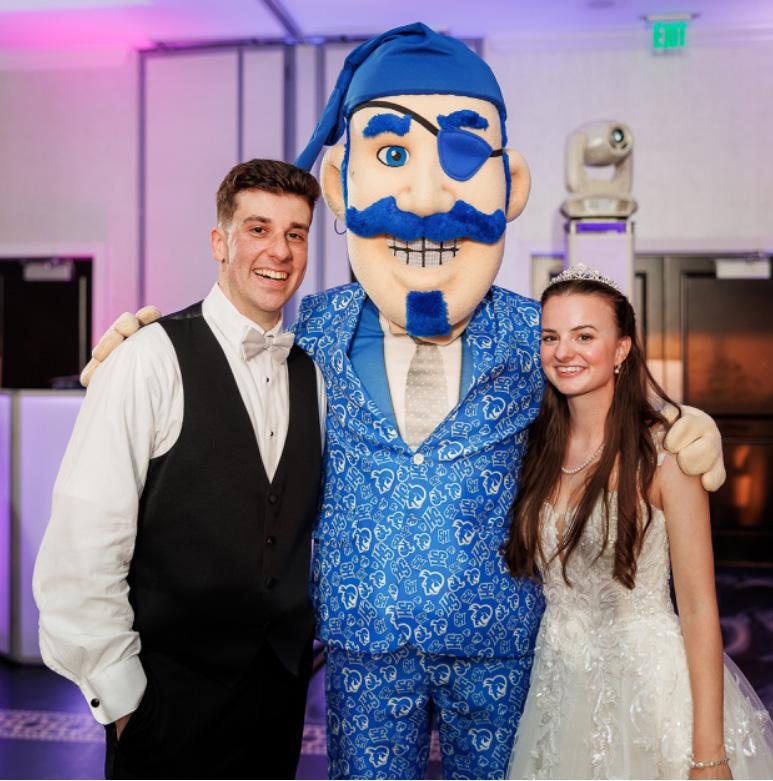
1. Sandra DeRose ’75, her sister, and other WSOU alumni spent a week in Tuscany, reminiscing about Seton Hall and showing their Pirate Pride after winning the trip at a WSOU anniversary dinner.
2. Lawrence Moran ’76 on a Symphony of the Seas cruise in August 2024.
3. Maureen G. Murray ’84 with fellow members of the Class of 1984.
4. Diana I. Ortiz-Miller ’89, Joan F. Kozdeba ’89, Maximina Rivera ’89 and Jennifer L. Holt ’89 — all former members of the White Roses, the sister organization to the Pershing Rifles — have remained close friends for over 40 years.
5. Mary Grace K. McNamara ’23, Elizabeth M. Rauchet ’22, Gabrielle A. Kuper ’23 and Lilly Michaels ’23, friends since meeting at Seton Hall, still meet every week in New Jersey. The group recently traveled to Savannah, Ga.
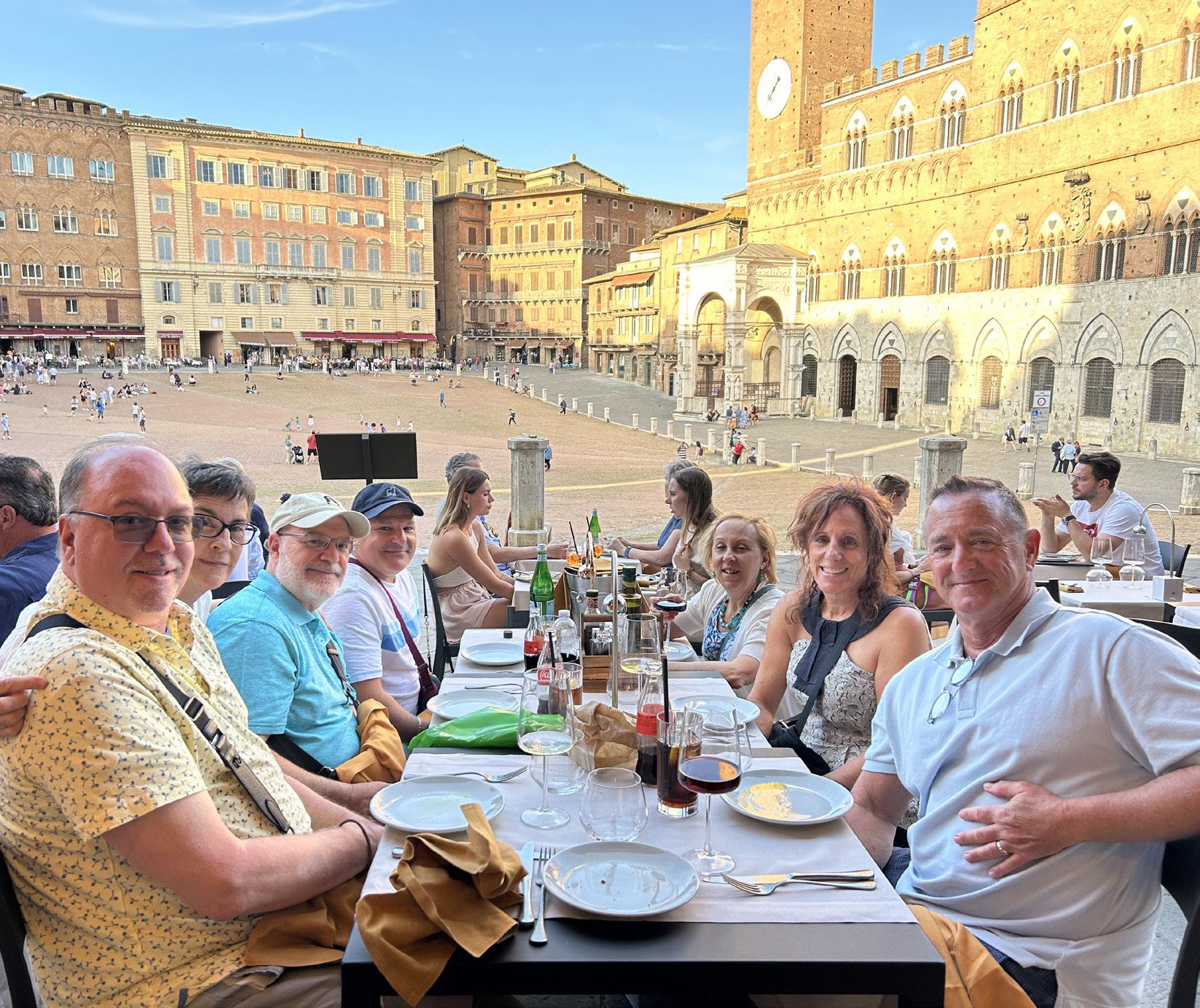
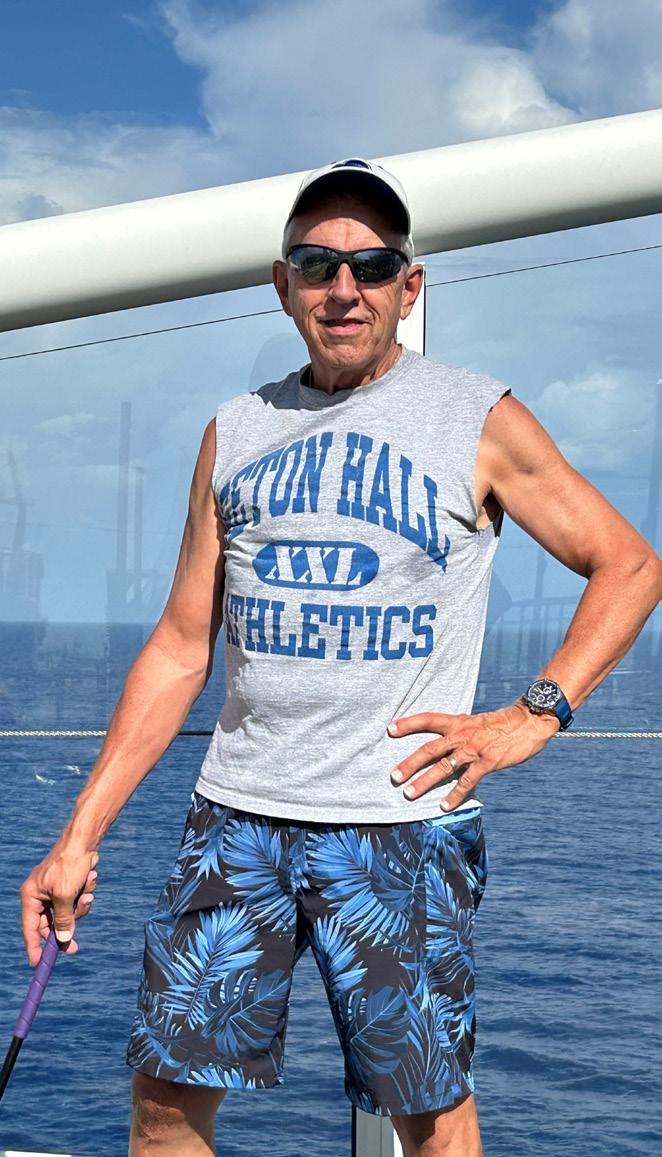

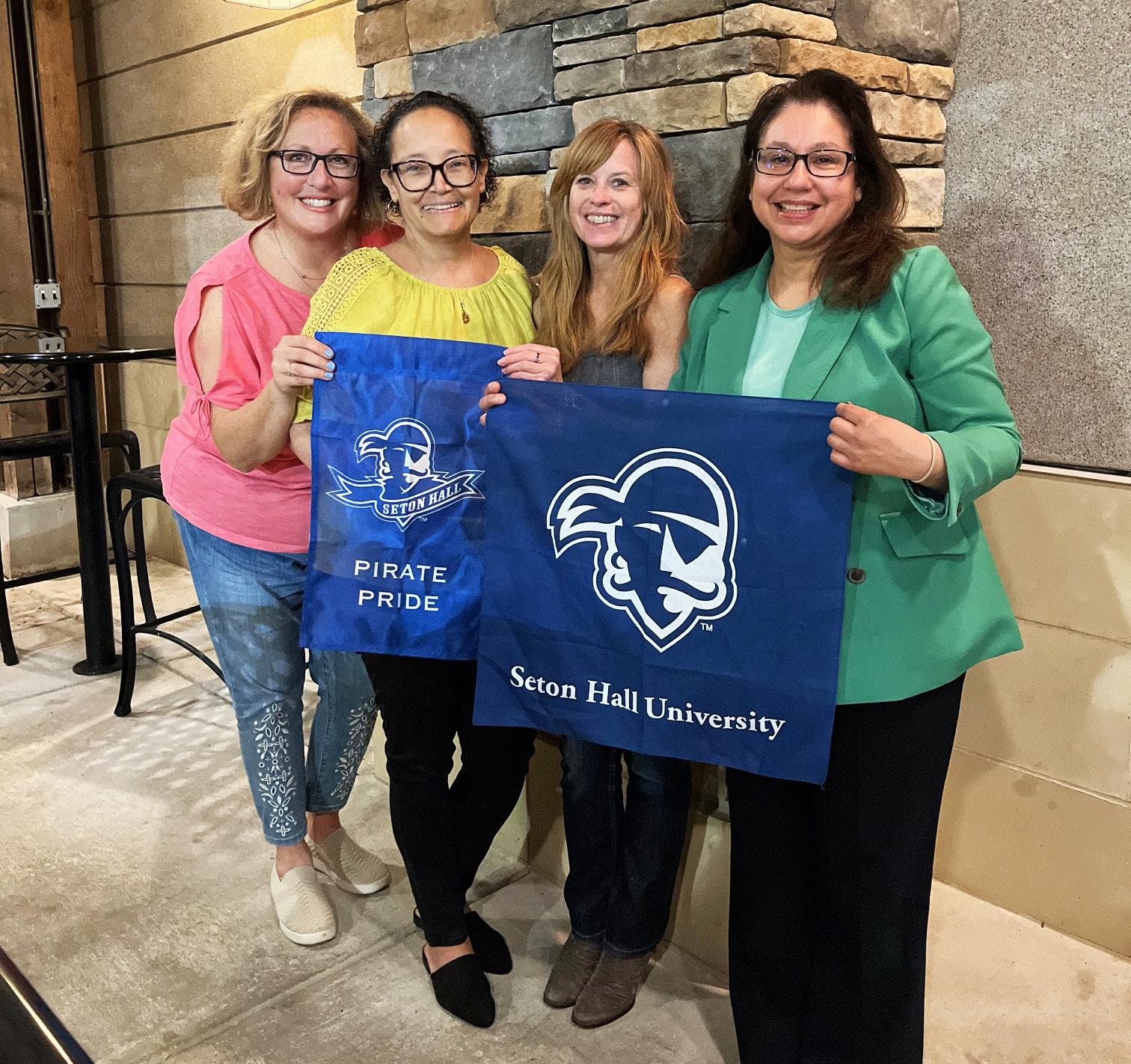
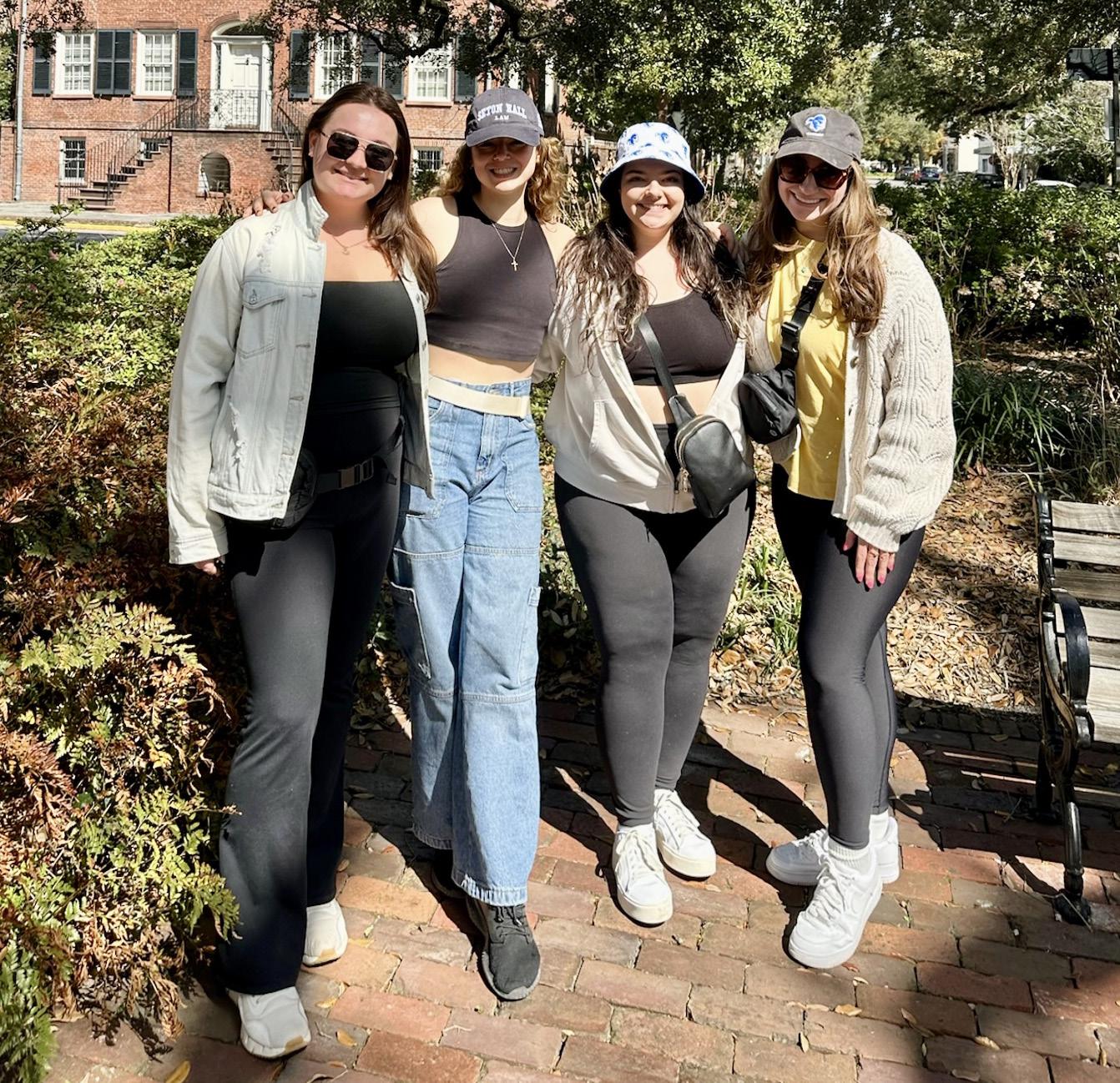

Have you been promoted? Earned an advanced degree? Been honored for professional or personal achievements? Recently married? Added a baby Pirate to the ranks? We want to know.
Send news to: Department of Alumni Engagement and Philanthropy

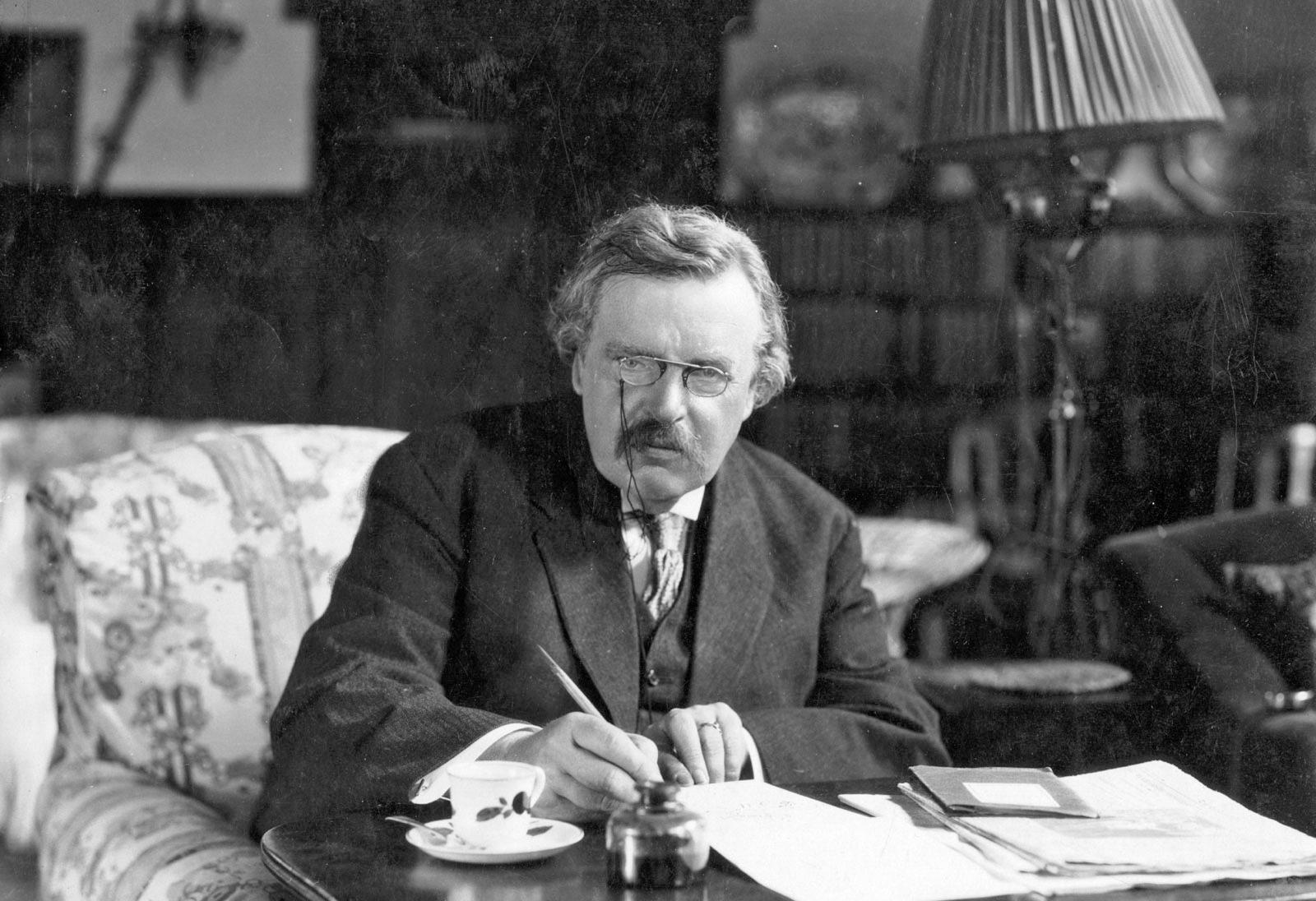
In January, the BBC launched the 12th season of its hit series Father Brown, based on the fictional crime-solving Roman Catholic priest created by G.K. Chesterton. Ever since Chesterton’s short stories were first published in 1911, Father Brown has delighted millions worldwide. Yet what’s even more influential than the pop-culture fame of his fictional character is Chesterton’s impact on Catholic thought. He stands as an important intellectual figure, a keen religious thinker who argued in defense of the Catholic faith and influenced countless other Christian thinkers.
Since 1999, Seton Hall has hosted the G.K. Chesterton Institute for Faith and Culture, dedicated to Chesterton, his work and his ideas. In light of the institute’s 50th anniversary, celebrated in 2024, Seton Hall magazine reached out to its director, Gloria Garafulich-Grabois, for more information.
To begin with, who was G.K. Chesterton?
He was an English writer, a prolific one. He was a novelist, playwright, poet, journalist, editor, theologian and philosopher. Beyond the Father Brown stories, he also wrote other well-regarded works including Orthodoxy, The Man Who Was Thursday and The Napoleon of Notting Hill. Chesterton converted to the Roman Catholic faith in 1922.
What made G.K. Chesterton special?
He was incredibly versatile. He could write about serious topics in a way that the general reader could understand. His writing still interests readers today, and his works have been translated into many languages. He’s one of the most quoted English-language authors worldwide. And so his writings and his ideas continue to be relevant.
What does the G.K. Chesterton Institute for Faith and Culture do?
Father Ian Boyd founded the institute in 1974 in Canada to promote Chesterton’s thinking. Since then, the institute has shared his ideas, bringing them to a contemporary audience. We host programs — lectures and conferences — in person and online, and we publish a highly praised journal, The Chesterton Review, with two double issues a year. We have also published special issues in Spanish, Italian, Portuguese and French. We produce a blog “Paradox, Wit and Wisdom” and we recently launched a podcast called “Speaking about Chesterton.” For 18 years, the institute has also cosponsored the University’s monthly Spanish Mass, along with Campus Ministry.
When did the G.K. Chesterton Institute for Faith and Culture move from Canada to Seton Hall?
It was 25 years ago that Monsignor Robert Sheeran, president of Seton Hall at the time, invited Father Boyd and the Chesterton institute to relocate here. Father Boyd retired in 2020 after 46 years as the institute’s president and the founding editor of The Chesterton Review. Upon his retirement, professor Dermot Quinn was named editor of the journal. At that point, Father Boyd was named president emeritus, and he continued to be involved in the institute until his death in January 2024.
What projects does the institute have planned?
This fall, we will publish a special collection of essays in honor of Father Boyd. n
Stay
